

How to visit Carrara Marble Quarries (including the best tours)
If I say Carrara probably one of the first images popping into your head, is an image of Michelangelo’s Donatello, or the white marble kitchen counter you dream about. Although we all know the final product, there are a few people who know where this precious rock comes from, and how it was extracted in antiquity and nowadays. With this helpful guide, you can learn how to visit Carrara marble quarries, the place where the magic happens.
Disclosure: anitabeyondthesea.com is reader-supported. When you make a reservation through links on my site, I may earn an affiliate commission, at no extra cost for you. That will help me keep the blog up and running. Thank you!
Table of Content
Some history of carrara marble, cava museo fantiscritti, cave di marmo tours, carrara marble quarry private tours, things to know before going, visiting the marble quarries on your own, exploring the most beautiful abandoned marble quarries, in conclusion is a carrara marble tour worth it.
Carrara marble quarries are known from antiquity for producing some of the finest white marble in the world. The quarries have been in operation for over 2,000 years since Roman times. At the time the marble was called marmor lunensis because of the neighboring city of Luni.
Through their centuries of history, they have supplied marble for some of the most impressive buildings and artworks in history. From the above-mentioned Michelangelo to Antonio Canova. And how not to mention the Pantheon or the grandiose San Peter’s Basilica which made large use of the “white gold”.
In modern times Carrara’s marble is still largely used, among the most famous projects the majestic Sheikh Zayed Grand Mosque in Abu Dhabi or the modern Oslo Opera House.
Today, even if the extraction activities continue, visitors can take guided tours to learn about the quarries’ rich history, discover ancient techniques, and marvel at the beauty of the white marble walls.
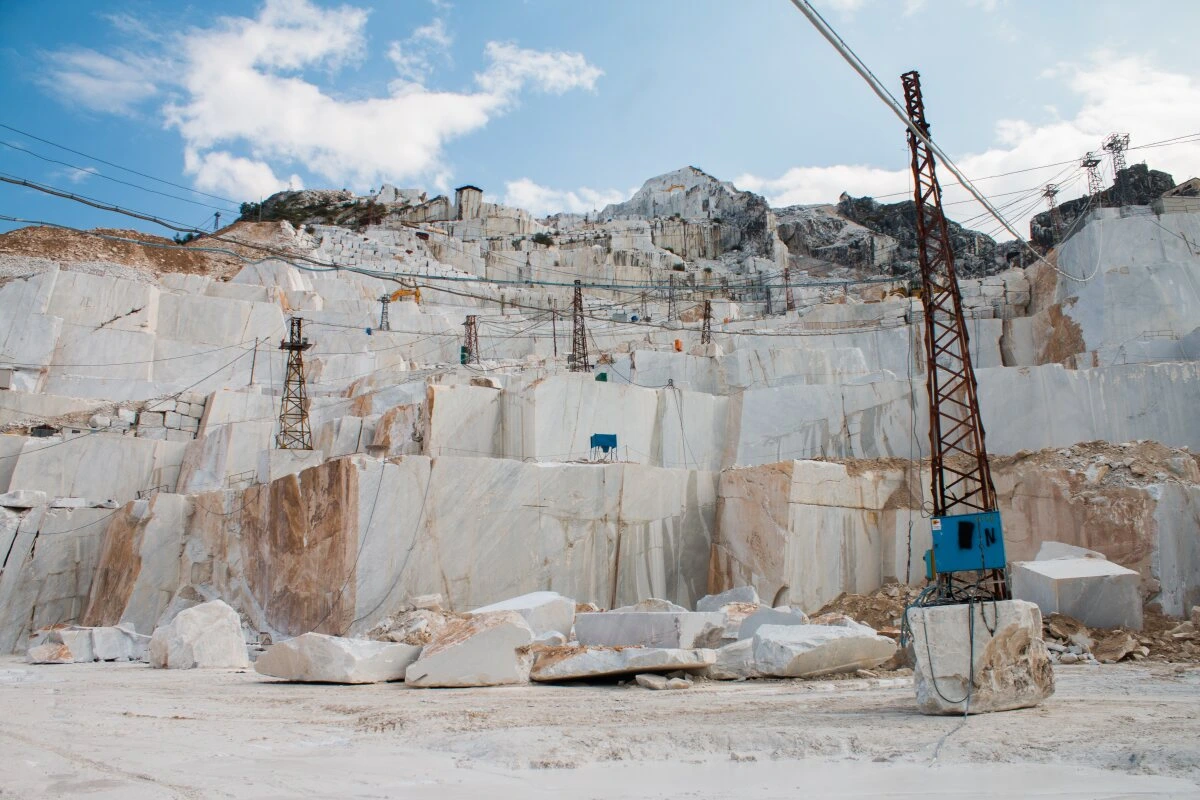
The best Carrara marble quarries guided tours
Note: following Covid restrictions some tours that included Colonnata’s lard tasting, have now removed it from their tour. Remember to ask for confirmation for the tasting to be included , if that’s important for you.
P.S. Colonnata’s lard is absolutely delicious!
Walter Danesi Sr. has collected the tools of his life as a quarryman and put them on display for everyone to enjoy in this open-air museum. From sculptures to everyday objects, his routine but also historical objects to understand how the excavation was with the traditional techniques. The tour is very interesting and can be easily combined with a 4WD excursion or Marmo Tour bus ride to see the quarries from the inside.
Before going check out their schedule or contact them directly on Cave Di Marmo Fantiscritti Carrara .
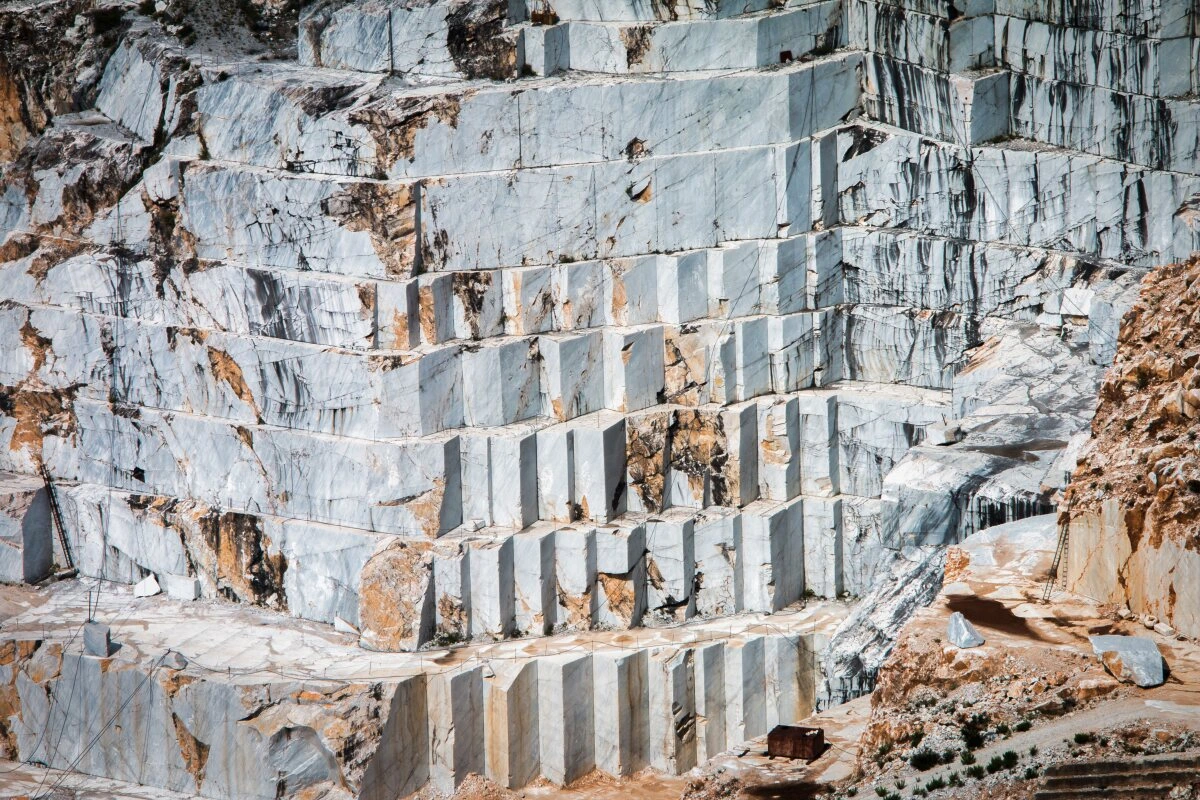
Marmotour covers the history of Michelangelo’s favorite source of marble, il Ravaccione . After a short bus ride, you will enter the active marble quarry, a shiny white cathedral.
During the tour, you will also get to see the tribute to Michelangelo by artist Ozmo. It consists in a giant mural that reproduces Michelangelo’s fresco “The Creation of Adam” from the Sistine Chapel.
Book Marmo tour
During the tour, you will get to see the different stages of marble extraction, from the cutting of the blocks to the transportation of the marble. The tour will also take you to some of the most breathtaking locations within the quarry, where you can enjoy beautiful viewpoints.
Cave di Marmo Tours has three different options for its tours. You can either embark on a 4WD with 15 or 8 places. Or book a private tour for your group, for 8 people max.
Book your Cave di Marmo Tours here: For 15 persons , 8 persons , or the private tour (8 persons max).

Differently from the other tours, the Carrara Marble Quarry Private Tour lasts 4 hours and in addition to the exploration of an active marble quarry, you will get to explore Carrara historic center with your guide. Of course, the tour includes a stop at one of Colonnata’s restaurants to taste their excellent lard!
Book Carrara Marble Quarry Private Tours
The 4WD tours are an incredible experience, but it is NOT suitable for the faint of heart! The narrow roads that run among the quarries have incredible views, but if you suffer from vertigo you may be disturbed. In the same fashion, some breathtaking views from the panoramic points are on top of deep cliffs.
Especially when exploring the interiors of the marble quarries it may be chilly . If you are particularly sensitive to the temperatures bring a jacket or scarf to protect yourself.
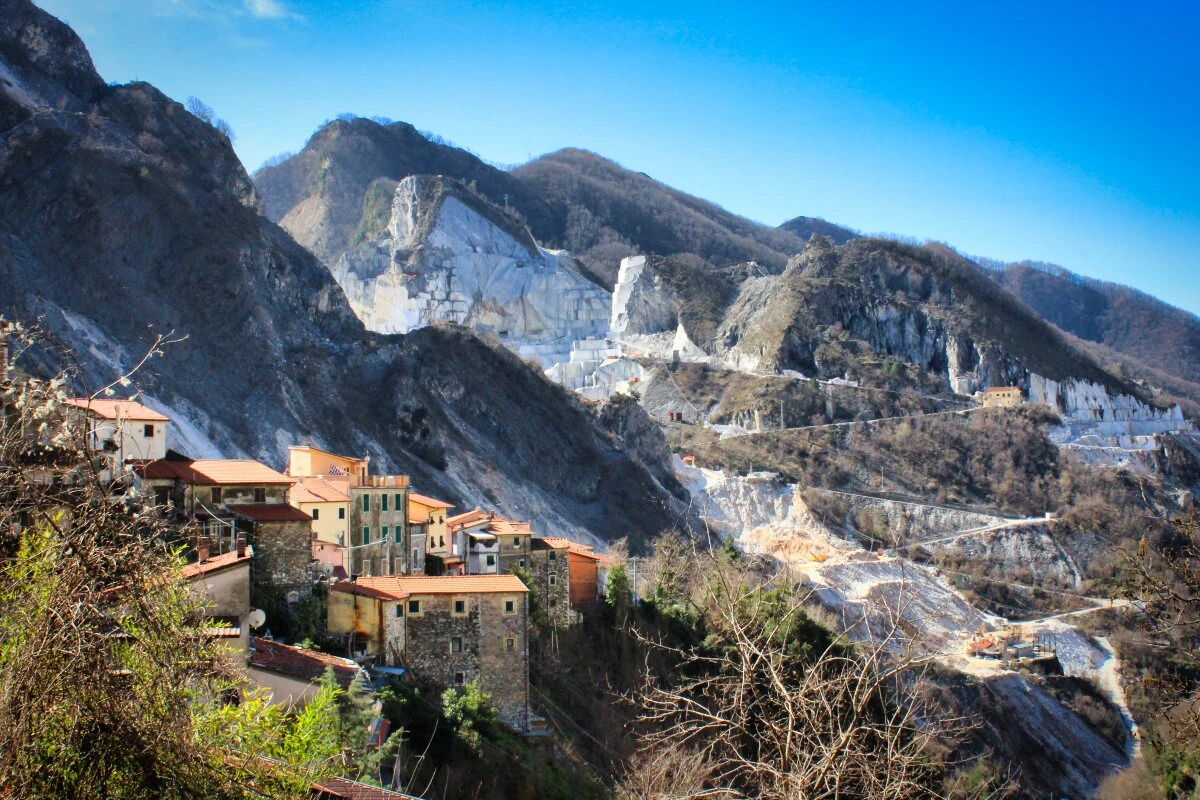
Ride along some of the most panoramic (and narrow!) roads in Italy. Reaching the quarries’ sites is already an adventure itself! Once you arrive in Colonnata village, you can take one of the treks that from there climbs up and observe the mountains open heart from afar.
A special mention for the scenic Vara Bridges . By the end of the 19th century, to speed up the transportation process, the Ferrovia Marmifera , Marble Railroad, was created.
After the war the system became obsolete and trucks took the monopoly of transportation instead. But the bridges stayed and they are now part of the beautiful landscape of the valley.
If you want to see the active marble quarries from the inside, the only way is via a guided tour due to the particularity of the location. The drivers have a special license to drive inside the quarries.
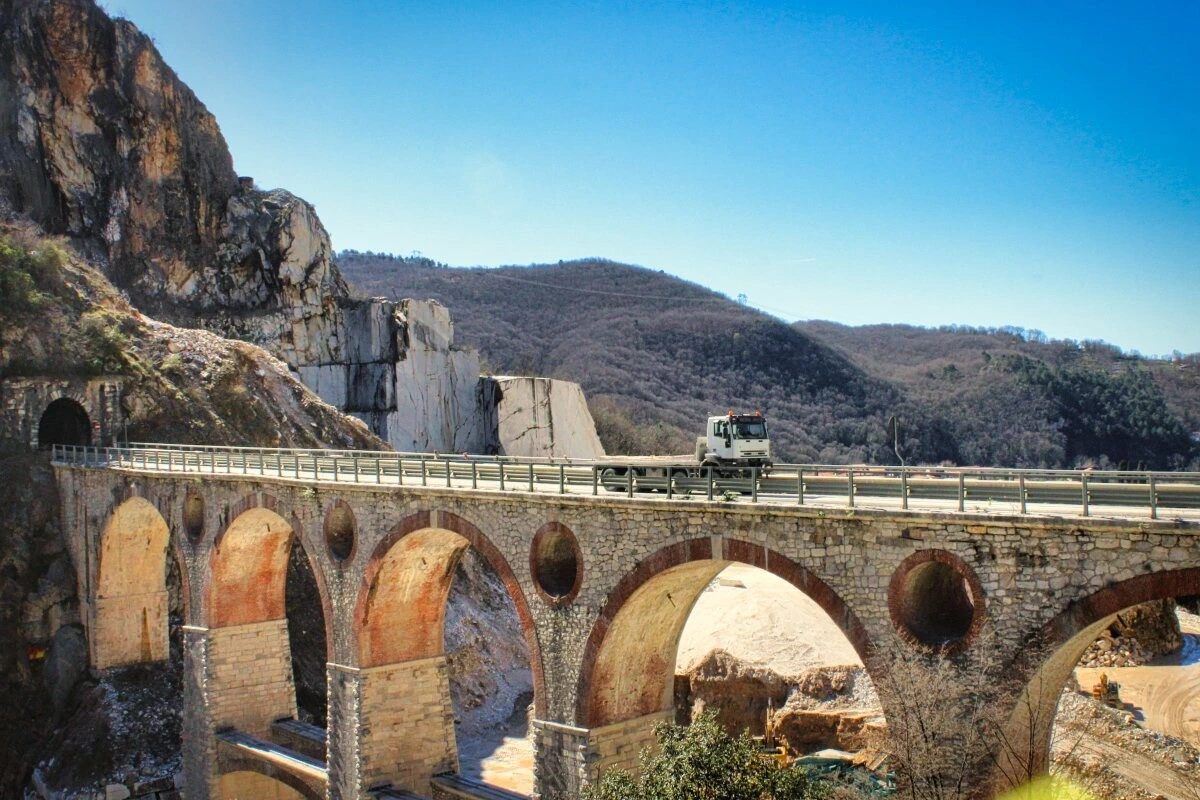
On the other side, in case you are willing to see an abandoned marble quarry you may be interested in our self-guided tour inside the 5 most beautiful abandoned marble quarries in Tuscany .
Got the time to pick only one? Go for Henraux . Its white walls have become the canvas to the art collective Glitch, who created some incredible murals!

Yes! It’s an unforgettable experience that offers a glimpse into the history, art, and craftsmanship of Italy. The beauty of the marble, combined with the history of the quarries, makes this a must-see destination for anyone visiting the Tuscany region of Italy.
Are you planning a vacation to Italy soon? As a Tuscan native, I have many more day trips and helpful guides that will inspire you to visit il Bel Paese!
Have you liked this post? Sharing is caring!

Carrara Marble Quarry Tour Guide
Map and guide to visiting the quarries above carrara.
- Maps of Italy >
- Tuscany >
- Carrara Marble Quarries Tour
Touring the marble mines in the Apuan Alps in northern Tuscany is an incredible visual experience--which is why the location was chosen for the chase scene in the James Bond film Quantum of Solace .
You can tour some of the marble mines above Carrara in a self-guided car tour, but to get as high into the Apuan Alps as we did in the picture, you'll need to take a jeep tour. The tour we took cost a reasonable €10, one of the best bargains in Italy. It gets you 1000 meters above the sea. Today that tour is €15. Still a bargain, but...
Map: Carrara Marble Tour & Lodging Locations
The map below is centered upon the Frantiscritti Mine Museum. Just a big south is the parking for the tour, and just to the north is the ticket booth and restaurant. You can see this in detail by zooming in on the map using the controls on the lower right. The map shows some lodging in the marble moutains if you wish to stay here.
Views from the Tour
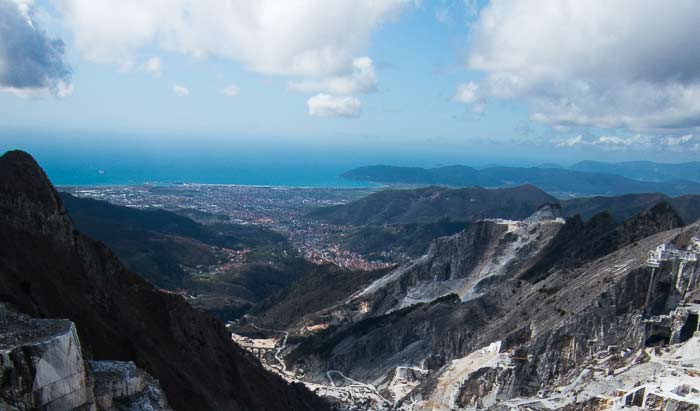
View from the Marble Quarries

Down Comes a Mountain
Carrara and the Marble Mountain Travel Tips
You will, of course, need a car to do this trip, unless you've arranged to use a guide or travel planner.
From the city of Carrara, follow the signs to the "cave" until you reach the Fantiscritti caves. There is a small museum there worth seeing. The restaurant, Ristorante il Poggio , has an annex where you can sign up for the tour if you've come in the off season without a reservation.
Where to Eat
If you haven't made a restaurant reservation before arriving at the Frantiscritti starting point, we suggest heading over to the nearby town of Colonnata , famous for its lardo , herbed backfat aged in marble vats that kept the marble miners in energy through the long winters. It's possible to tour the lardo workshops. There are quite a few restaurants in Colonnata. You don't have to eat lardo in any of them, but you should try it. It's much healthier then butter when a thin slice is laid over a piece of toasted bread. Our latest fave restaurant in Colonnata is Osteria Nella Pia .
Where to Stay
Consult the map above for places to stay in the mountains. But if you'd like to stay in a marble city, we've found that of the two marble towns, Massa is perhaps the most interesting, and you can retreat to Marina di Massa to be closer to the sea.
I prefer to stay where the marble is turned into art, in nearby Pietrasanta . See: An Art Itinerary in Tuscany .
Guide Services
We recommend Serena Giovannoni of Wish Versillia as a guide who can provide comfortable transportation and guide services from wherever you are in Versillia (this area of Tuscany), especially useful if you do not have a car or if you just want to leave the navigating to someone else. The roads in this area are narrow and confusing. Leave the driving to someone who knows the way.
Location and Contact information
Carrara marble tour (50 minute 4x4 jeep tour).
Cave di Fantiscritti , Italy
Latitude: 44.090777975 Longitude: 10.133441103
Near Carrara
Where to go from here? Once you've seen the raw materials you may wish to visit the workshops, many clustered around Pietrasanta , a very nice town to stay in. If a spa appeals to you more, Montecatini Terme may be just what you're looking for. Lucca is also nearby. It is about an hour and a half drive to Florence .
If you are a lake lover, bird watcher, or like to walk on planks over wetlands (and see a Roman Villa overlooking it all), a trip to Lake Massaciuccoli might be in order.
Or, you may wish to explore other options in Tuscany .
More Italy Travel Planning Resources
- Travel Planning Timeline : Learn what you need to plan when.
- What Will an Italy Vacation Cost? : Tools for budgeting your Italian vacation.
- Unplanned Attractions : Save time for the good life in Italy.

- Liechtenstein
- Netherlands
- Switzerland
- Solo Location Guides
- Solo Travel Advice
- Solo Inspiration
- Luxury travel
DESTINATIONS , EUROPE , ITALY
Visiting the carrara quarries: italy’s marble mountains.
As a Renaissance fangirl visiting the Carrara marble quarries was a must. But I didn’t anticipate how spectacular these marble mountains in Italy’s Apuan Alps would be.
They are an extraordinary sight. Although you would be forgiven for thinking that they are snow-capped peaks, their quarried faces glisten with marble.
To learn more about one of Italy’s most iconic exports, discover how to visit the fascinating and spectacularly scenic Carrara marble mines.

Why Carrara Marble is So Special
Carrara marble is famed for its high quality and beauty. It has been quarried since Ancient Roman times , then called the “Luna marble.”
The deposits were next to the sea which was ideal for transportation. In those days the marble was rolled down the mountain by hand.
This was the Renaissance ’s raw material and was the starting point for many of Florence’s finest sculptures . It can be seen in cathedrals, sculptures and monuments, from the sublime cathedral in Orvieto to the Pantheon, one of Rome’s most famous landmarks .
Michelangelo made many trips to Carrara to select pieces of the stone for his works, including David in Florence and the Pieta in St. Peter’s Basilica in Rome. It is said that David was inspired by the brawny Carrara masons.

White Carrara marble is prized because of its purity (it is 98-99% calcium carbonate). Due to its softness, it is the ideal raw material for sculpting.
Carrara blue-grey marble is harder and has more impurities, namely carbon, clay and iron. This makes it good for building.

How to Visit the Carrara Marble Quarries

Carrara Marble Tour offers a 50/60-minute excursion from March to November. In 2023, it costs 15 euros per person.
Tours are in Italian or English. You don’t need to book in advance unless you are part of a group of at least 20 people.
There is also a small museum, gift shop, restaurant and toilet facilities. In summer, there are mini-bus tours inside the mines.

Although it is possible to visit some of the Carrara mine areas and the museum under your own steam, I recommend taking the tour. The views alone warrant the modest cost and you get to see the quarries close-up.
My Experience of the Carrara Quarry Tour
I joined a one-hour excursion conducted by Carrara Marble Tour . It offered an excellent insight into the quarrying of this precious limestone.
Staring at the parking lot at Fantiscritti, our guide and driver Pipo bundled us into a 4×4 and negotiated his way along a steep marble road to quarry n.83 Canalgrande Alto , one thousand metres above sea level.
The views from here over the Apuan-Versilian coastline and the Ligurian Sea were sensational.

The quarrying industry in Carrara directly employs about 1000 workers. Quarrymen are just that; the labour force is almost 100% male and working here is a tradition passed down through generations of local people.
There is a solitary female; the site’s Health & Safety manager. It takes a woman to keep this many men under control!

Marble is quarried at Carrara year-round, stopping only when heavy rain makes conditions on the access road dangerous.
This can be a hazardous occupation. Pipo told us that in the last ten years, 14 people have died. On a more positive note, the mine’s safety record is improving.

In the distance, we could see the quarrymen hard at work.
A large block of marble called a bancata, is cut from the ground and is then split into smaller blocks with diamond chains. But small is a relative term as these blocks weigh in at 20 tonnes. The blocks are then taken to the harbour of Carrara for shipping to China where they are cut and processed.

Quarrying marble is hard work and the men need sustenance. The typical meal of local miners is lardo di Colonnata I.G.P., a herb-infused backfat that is left to age in white marble vats in the nearby village of Colonnata.
At the end of the tour, you get to try lardo, cut into thin slices, with a glass of red wine. It wouldn’t be my first choice of lunch, but when in Carrara …

If the Carrara quarries look familiar, that may be because they were featured in the opening car chase of the 2008 James Bond Quantum of Solace blockbuster (one of my favourite movies filmed in Italy ).
How to get to the Carrara Marble Mines, Italy
The Carrara marble quarries are in Tuscany , around four miles northeast of the city of Carrara at the foot of the Apuan Alps.
By car , Carrara is an hour north of Pisa or a 90-minute drive south of Genoa. To get to the starting point of the tour from Carrara, follow signs for Cave and then Fantiscritti.
If you don’t have a car, the nearest railway station is Carrara-Avenza which is on the Genoa-Pisa branch line.
I visited the Carrara marble quarry as a shore excursion from Livorno , a popular port of call on cruises of the Western Mediterranean.
Will Carrara Run Out of Marble?
This was my burning question at the end of the quarry tour.
With limitations on mining, it is thought that there will be Carrara marble for the next 400 – 600 years. Without these restrictions, Carrara may run out of marble within 200 years.

About Bridget
Bridget Coleman has been a passionate traveller for more than 30 years. She has visited 70+ countries, most as a solo traveller.
Articles on this site reflect her first-hand experiences.
To get in touch, email her at [email protected] or follow her on social media.
Private Carrara Marble Quarry Tour
What to expect.
LivTours Private Carrara Marble Quarry Tour is an exciting, adventure-packed day trip that offers a 360-degree overview of the marble that was so popular during the Renaissance. This experience will take you to the Marble Quarries of Carrara via Land Rover, making it a perfect family activity! Enjoy the thrill of this action-filled day at the quarries with your local expert guide who will tell you the details about Michelangelo’s favorite materials. This is a highly visual experience that is perfect for any art lover!
This truly unique experience is a fantastic alternative for families or history lovers who are staying in Florence and are curious to see a different side of Italy – a more adventurous one! Once in your Land Rover, your guide will take you up a bumpy ride to the quarry. With an up-close view, you will soon understand that this is no ordinary tour, this is an experience. Enjoy the stunning views as you drive into man-made marble caves and along scenic cliffs.
Pack your cameras for this exciting adventure!
Why book this tour
- Experience an active marble quarry site via Land Rover - a true Italian adventure
- Learn all about Carrara marble, Michelangelo's raw material, where & how it is mined
- Enjoy a Land Rover ride in the Apuan Alps with breathtaking views & amazing heights
- Explore Carrara & Carrara marble with a private tour guide
- Learn about 2000 years of history in one adventure filled Tuscan afternoon
Exclusive private Tours and Experiences. Also offered in Spanish, French, Portuguese, Swedish and Russian
Our prices always include tickets and reservations fees (no waiting in lines!)
Our tour guides and staff are selected experts and speak perfect English
Easy to book and prepay your tours with our secure payment system
Eco-sustainable tourism, designed to respect and support local culture, art and traditions
Tour gallery
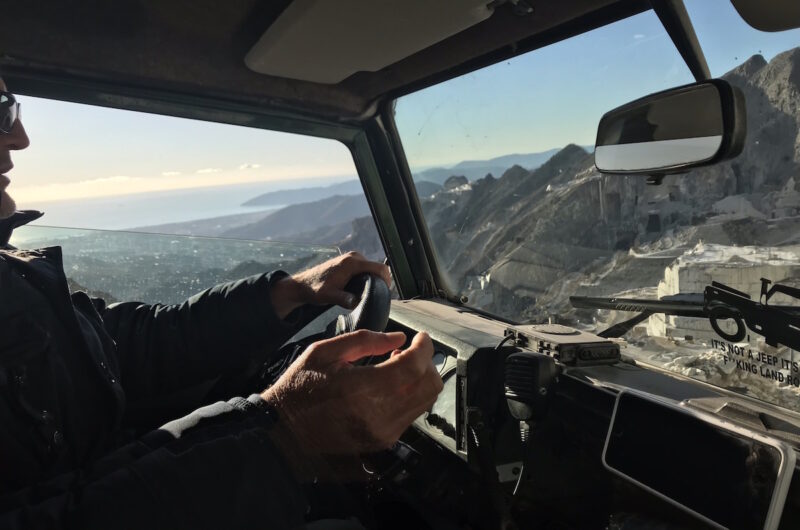
Read more about your Carrara marble quarry tour
Your LivTours Private Carrara Marble Quarry Tour starts when you meet your expert guide in Carrara, a village in the Alps located in northern Tuscany. Your guide will meet you in a Land Rover as you experience the adventure of an uphill ride, take time to reflect on the gorgeous valley scenery below. We already know that true art is not for the faint of heart, but the rocky quarry roads drive that point home as you realize the enormous effort put into just getting the raw product. No wonder Michelangelo used a discarded piece of marble, albeit a big one, to carve The David!
A massive mountainous quarry, entirely made of the famous grey-veined Carrara marble leaves you awe-struck with the realization that this is the building material of the great Roman Empire. This is the raw material of more epic and older masterpieces that Michelangelo’s David such as Rome’s Pantheon, Trajan’s column, and countless more. These quarries have been in use since Roman times and nearly 2000 years of art, architecture, and sculpture, and now is your chance to partake in that rich history!
Your guide will tell you stories that run the gamut of ancient Romans all the way to Renaissance greats like Michelangelo and Baroque geniuses such as Gian Lorenzo Bernini. These are the artists who made Italy the classical art capital of the world and this is the marble that helped them achieve their goals!
VISIT AN ACTIVE MARBLE QUARRY | THE ULTIMATE ADVENTURE This Carrara Marble tour spares no expense when it comes to authenticity, as this is a functioning quarry you should expect to see crews digging deep into man-made caves for marble. Here you will learn about the contribution which Carrara marble has made not only to the world of art but also to the world of Italian oil. Your private guide will share with you the stories from this mountain filled with 19 miles of marble.
The 2,000-year-old story of Carrara marble is not only filled with romantic tales of legendary sculptures and landscape beauty but a laborious effort that goes into extracting marble from the quarries and the local feuds which have ruled this area for generations. Find out the inside scoop on who holds the fortunes to the Carrara mines, about their clientele from past and present!
The views alone from the Apuan Mountains, an Italian mountain range in northern Italy not to be confused with the similarly named Alps, down across Tuscany are worth a visit alone. The opposing visual forces of the active mining area behind you, with the beauty of nature is simply a spectacular view like no other.
Come join us for a day of adventure and make memories to last a lifetime!
Once your tour is over, your private tour guide will take you back to your meeting spot to finish off your ultimate Italian adventure.
This Tour Includes
- See where Michelangelo got his marble
- Explore Carrara mines via 4-wheel drive
- Fully guided experience
Our Sustainable Tourism Promise
LivTours’ group size of max 6 participants is and always has been based on sustainable travel, and we are proud to be at the forefront of change and innovation in the industry. LivTours is committed to providing travelers with truly sustainable tours with the lowest possible environmental impact, all while supporting the local industries and people of each unique destination. To learn more about how you can actively support sustainable tourism and how LivTours is contributing, click here .
About our Private tours
When you book a LivTours Private Tour or Experience , you are guaranteed a dedicated, expert guide that allows you the flexibility to start your tour at a time which is convenient for you, making planning easy. Our private tours ensure that you will get a tailored experience to meet all your needs so we go at your pace, perfect for families with younger children, elderly, or individuals with accessibility needs. Please be advised that all private tours begin at a base price starting at two people* . Prices are inclusive of entry tickets where applicable. *Some Ferrari private experiences are inclusive of one person only.
Just fascinating
The Carrara Marble Quarry, where Michaelangelo (and many others) went to get the marble slabs that then became the scupture masterpieces that we know, is a fascinating place. The chance to visit the Quarry, see how they cut the marble from the sides of the mountains and then transport these gigantic stones is extremely interesting and for both my husband and myself, an experience we won't soon forget. Thank you LivItaly for offering such a creative and fascinating tour!
Choose dates later / Buy as a gift
By selecting Choose Dates Later / Buy as Gift at booking, any tour can be purchased without fixed dates. This is the perfect option if you want to purchase your tour as a gift for a loved one, or if you are in the pre-planning phase of your vacation. After booking, you will receive a Travel Voucher Code and full instructions on how to schedule your tours when ready. Once your travel plans are confirmed, you can easily use the Travel Voucher Code on the LivTours website to formally schedule your tours. You can find out more here .
Book your tour
Privacy overview.
Carrara Marble Quarry Tour with Food Tasting

- Geologist and stone expert guide
- Via Miseglia Fantiscritti, 54033 Carrara MS, Italy
- Not wheelchair accessible
- Near public transportation
- Confirmation will be received at time of booking
- Most travelers can participate
- This experience requires good weather. If it’s canceled due to poor weather, you’ll be offered a different date or a full refund
- This tour/activity will have a maximum of 8 travelers
- For a full refund, cancel at least 24 hours in advance of the start date of the experience.
Similar experiences

- You'll start at Via Miseglia Fantiscritti Via Miseglia Fantiscritti, 54033 Carrara MS, Italy See address & details
- 1 Ponti Di Vara Stop: 60 minutes See details
- 2 Colonnata Stop: 60 minutes See details
- You'll return to the starting point
Most Recent: Reviews ordered by most recent publish date in descending order.
Detailed Reviews: Reviews ordered by recency and descriptiveness of user-identified themes such as wait time, length of visit, general tips, and location information.
Buy it with

Carrara Marble Quarry Tour with Food Tasting provided by Carrara Marble Tours
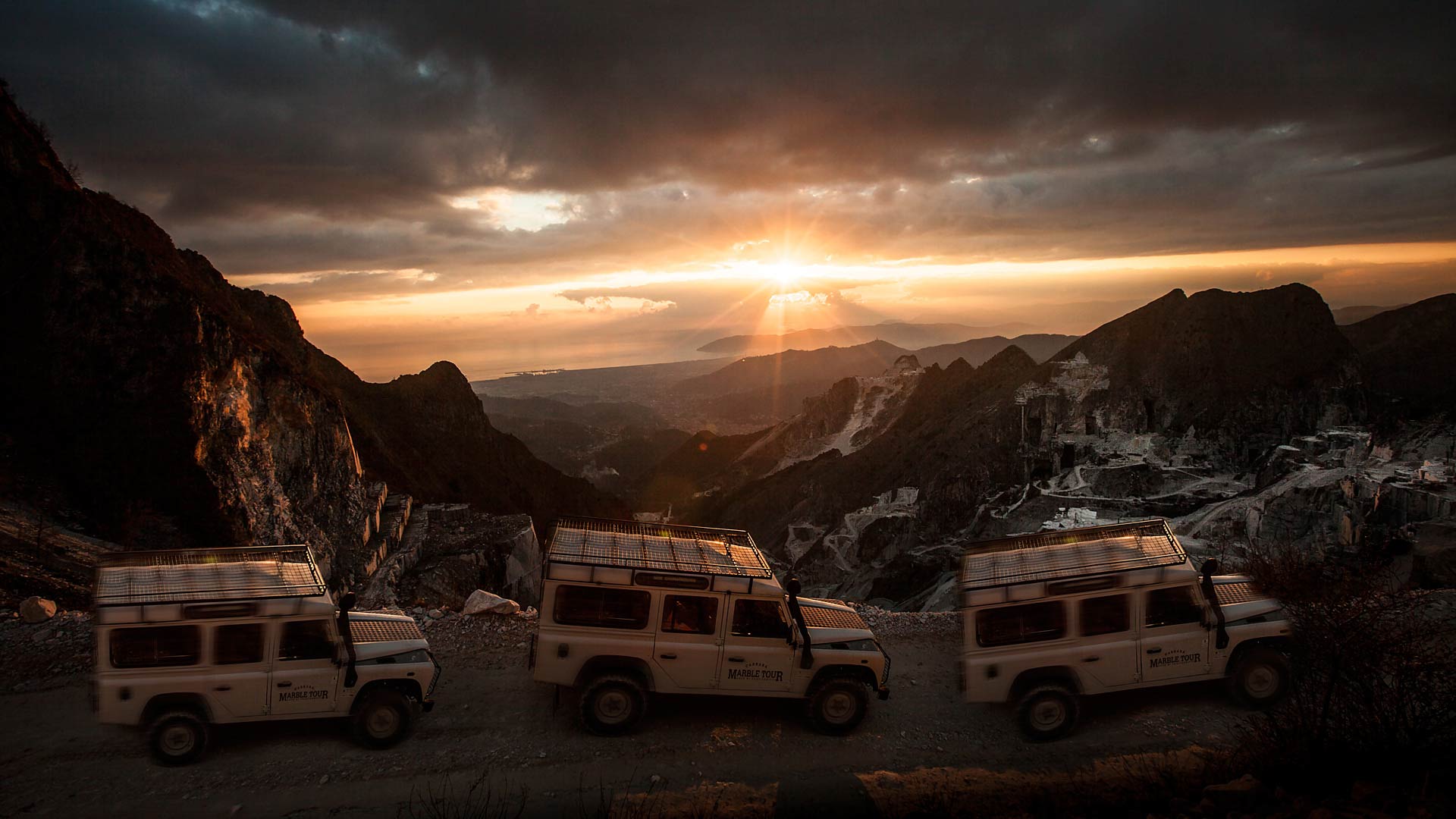
CARRARA MARBLE TOUR
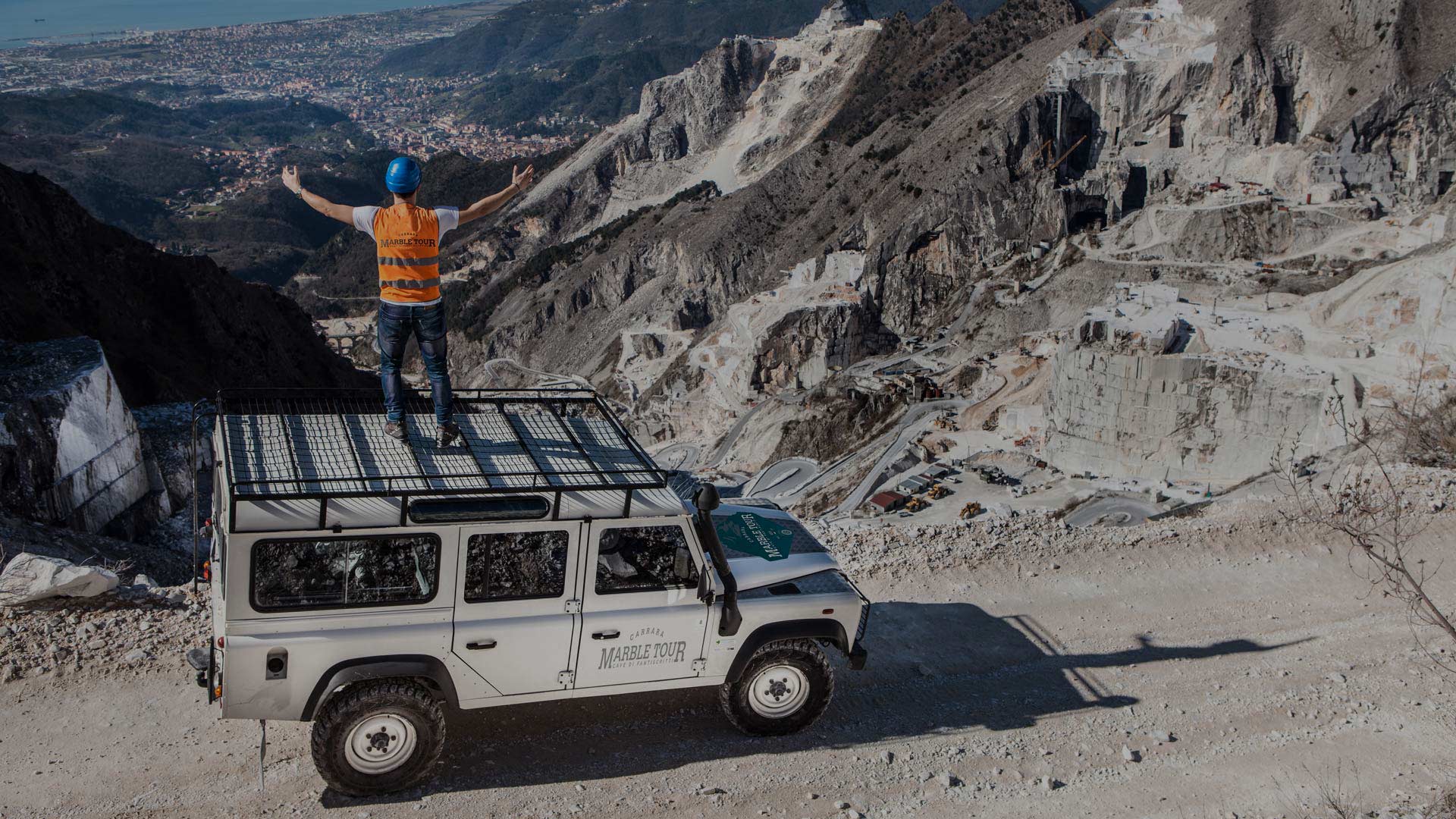
Carrara marble tour
Benvenuti a
We are open every day, holidays included, from 1st March to 2nd November , from 10 am to 5 pm. Attention: reservations are accepted for groups of at least 20 people. For groups of less than 20 people reservation is not necessary , come and enjoy the first available tour. Once you have arrived at the meeting point by the Fantiscritti quarry yard, you would be able to book the first available tour. There are 6 jeeps with 8 seats plus driver each and one tour starts every 20/30 minutes (waiting time may decrease or increase due to the number of people).
In the yard there is a large parking area that can host large coaches and an important artistic workshop (which cannot be visited for safety reasons).
Check Availability

Marble Tour

Marble: Michelangelo and marble in Carrara
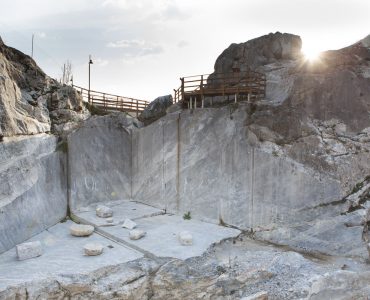
Marble: the history of marble from the Roman age until today
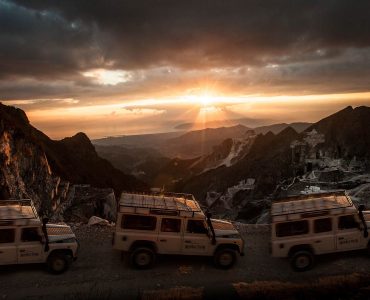
Marble: Main uses

- +39 392 6037948
- Via Aiaccia 37/A 57014 Livorno, Toscana, Italy --> Via Aiaccia 37/A 57014 Livorno, Toscana, Italy
Carrara Marble Tour
Discover the carrara marble quarries aboard powerful 4x4 jeeps.
During the visit to the Carrara quarries you will admire enchanting views of the Apuan Alps . The Carrara marble tour is carried out in a 4 × 4 Jeep with the assistance of expert guides who will reveal the history of these places and the techniques used over the millennia for the extraction of marble and the continuous challenge between man and the mountain where Michelangelo found the raw material for his works among the most important in the world.
CARRARA QUARRIES TOUR AT A FIRST GLANCE
- 8.00 am – meeting and pick-up at your accommodation in Pisa, Lucca or at the port of Livorno
- 9.30 am – arrival in Carrara
- 10.00 am – start of the tour aboard the 4X4 Jeeps
- 1.30 pm – tasting of the famous “Lardo di Colonnata”
- 2.30 pm – departure and return to your accommodation in Pisa, Lucca or the Port of Livorno
This itinerary is intended only as an orientation guide. All our tours are flexible and can be modified at will , in case you want to add or remove something from the program.
Do you need more informations before booking?
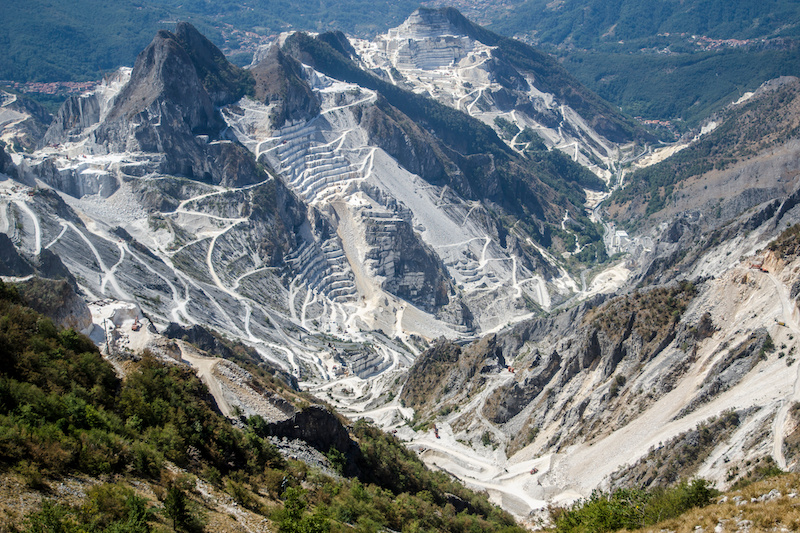
A visit to the Carrara Marble Quarries is much more than a simple tour
The visit to the marble quarries of Carrara is a journey to discover the material that has inspired artists of all times; it is the amazement of a unique place in the world; it is the encounter between the wonders of nature and the effort of men who have been extracting marble for over 2000 years, transforming the appearance of the Apuan Alps .
Located about 50 minutes by car from Pisa and Lucca, a few km from the border between Tuscany and Liguria, the Apuan Alps proudly show their whiteness and offer themselves as an exceptional viewpoint over the Gulf of La Spezia and the splendor of the 5 Terre .
Where to start to visit the Carrara quarries
The itinerary to visit the Carrara quarries obviously starts from the city of Carrara, easily reachable by any means of transport.
Michelangelo’s David and Pietà, the futuristic Arche de La Défense in Paris, the Library of Congress in Washington and the Opera House in Oslo are just some of the works created all over the world and in all times with Carrara marble , considered one of the finest materials in the world. Its dazzling whiteness, its aptitude to be worked and transformed, its perfection led first Julius Caesar and then Augustus and subsequent emperors to use it to embellish Rome. The Trajan’s Column, the Pantheon, the Arch of Constantine still tell us about the great history of Rome.
The unique charm of the Carrara Marble Quarries has also inspired Italian and international directors: some scenes of famous films were shot here such as the car chase of 007- Quantum of Solace , Michelangelo Infinito by Emanuele Imbucci, Al Lupo, al Lupo! by Carlo Verdone and Il Capo , a film by Yuri Ancarani dedicated to the life of the workers of the quarries.
Carrara marble cave tour in detail
Visit the Carrara Marble Quarries and let yourself be conquered by a place of absolute and inimitable beauty: we take care of the whole organization and you just have to have fun. In fact, we use 8-seater minibuses to pick up customers staying in hotels, B & Bs, agritourisms and holiday homes in Lucca and Pisa at the place of overnight stay.
And here is the program: we leave at 8:00 to reach Carrara at 9:30. Here, a tour guide awaits us with powerful 4×4 Jeeps , always 8 seats, capable of climbing up to the most famous marble basins , along the winding and suggestive roads that lead to the immense open-air quarries and those hidden in the bowels of the mountains. The Carrara Marble Tour by jeep then starts at 10:00!

The marble basins
Located at over 1000 m above sea level, the Miseglia Basin develops near the Bridges of Vara, an infrastructure built in the late 1800s for the transport of marble blocks by rail. These bridges today represent the road used by heavy vehicles.
In the same area we find the Torano Basin , where the Michelangelo quarry is located. The great artist, in fact, wanted to personally choose the marble to use and identified here the blocks that would give life to some of his works.
Going down around 500 m a.s.l. you can visit the Colonnata Basin , with its 500 hectares of quarries. During the visit to the Carrara quarries you will admire enchanting views while the guides will tell in Italian and English the history of these places and the techniques used over the millennia by the men who dedicated their lives to the extraction of marble. Imagine, for example, that in the 1960s blocks were transported by sliding special sleds on a series of wooden beams. The very difficult and tiring task of guiding the heavy blocks with cables and poles along slopes, cliffs and curves to the “loader hill” fell to the workers. The sleds were called “lizze” hence the name of “lizzatura” given to this method of transport.
At the end of the Marble Tour Carrara , lasting about 3 hours, a stop in Colonnata is scheduled for a taste of the famous lard : placed to mature in marble tubs, it will amaze you with its delicate, sweet and spicy taste.
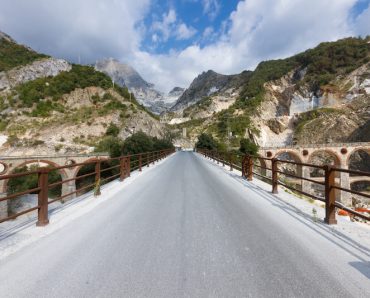
LOOK AT WHAT OUR CUSTOMERS SAY ON TRIPADVISOR
Login to access different features.


- Carrara Marble Tour
Guided tour visiting Carrara and exploring the quarries of the famous Carrara’a marble from Florence, Siena and all the main destinations of Tuscany. Off road adventure in the spectacular scenery of the Carrara marble quarries.
TOUR HIGHLIGHTS
- Private Carrara marble’s quarries tour from Tuscany with private English speaking driver and transportation
- Learn all about Carrara marble with a friendly English-speaking guide
- Off road adventure in the Carrara marble quarries
- The charming towns of Carrara and Colonnata
TOUR DESCRIPTION
Discover how the famous material used for architectural and artistic works that embellish squares, palaces, and private buildings all over the world is mined joining a tour in Carrara and in the marble quarries .
The tour starts with your private English-speaking driver picking you up in a luxury vehicle from your accommodation, for arriving in the Apuane mountains region, the area in Tuscany famous for the white marble of Carrara. Staring from the headquarter of the marble quarries, and using an off road vehicle, your friendly English speaking guide will lead you through a steep road connecting many quarries, heading an altitude of almost 1.000 m above the sea level and enjoying breathtaking view over the mountains and the Tuscan coastline. Inside the quarrying site, tour guide will also give you all the information about both ancient and modern methods of excavation , explaining all their stages of evolution in direct contact with the quarrymen at work.
Tour continue in the charming town of Carrara exploring its beautiful streets and squares, and in the lovely town of Colonnata discovering how Lardo di Colonnata is aged into white marble vats and tasting it with a delicious bruschetta.
Tour available from :
- The Carrara Marble Tour is a private activity available with transportation from Florence, Siena, Cortona, Montalcino, Montepulciano, Chianti, Pienza, San Gimignano, Val d’Orcia area, Arezzo and from all the main tourist sites of Tuscany.
- approximately 8-9 hours
Inclusions:
- Transportation with qualified and professional English speaking driver and luxury vehicle Mercedes-Benz or equivalent
- Head office assistance and insurance coverage
- English speaking tour guide during the marble quarries tour
- Transportation with off road vehicle in the marble quarries area
- Lardo di Collanata tasting
Carrara marble: it is a type of white or blue-grey marble popular for use in sculpture and building decor. It has been quarried since Roman times in the mountains just outside the city of Carrara, the northernmost tip of Tuscany, Italy. More marble has been extracted from the over 650 quarry sites near Carrara than from any other place. The pure white statuario grade was used for monumental sculpture, as “it has a high tensile strength, can take a high gloss polish and holds very fine detail”.
- Bike & Wine
- Hike & Wine
- Classic Cars Tours in Tuscany
- Vintage Vespa Tours in Tuscany
- The Grape Harvest
- The Olive Harvest
- Sailing in Tuscany
- Ballooning in Tuscany
- Artisan Workshops Tour in Florence
- Shopping at The Mall Outlet in Florence
- Ferrari Driving Experience in Tuscany
- Palio di Siena Experience
- Be a Local Tourist in Tuscany
Are you interested in our tours?

Tuscany and Italy Tours and Daytrips
Private driver and car service, wine tours and wine tasting experiences, transfers and shuttle service, food & wine tours and culinary experiences, limousine service, get tours recommends.

Tuscany Tour in Montepulciano, Pienza and Montalcino
Tuscany tour in siena and san gimignano, florence day tour from tuscany, montalcino and montepulciano wine tour. wine tasting experience in tuscany, food & wine tour in chianti.

Carrara Marble Quarries Tour: 4×4 Off Road Trip in Tuscany
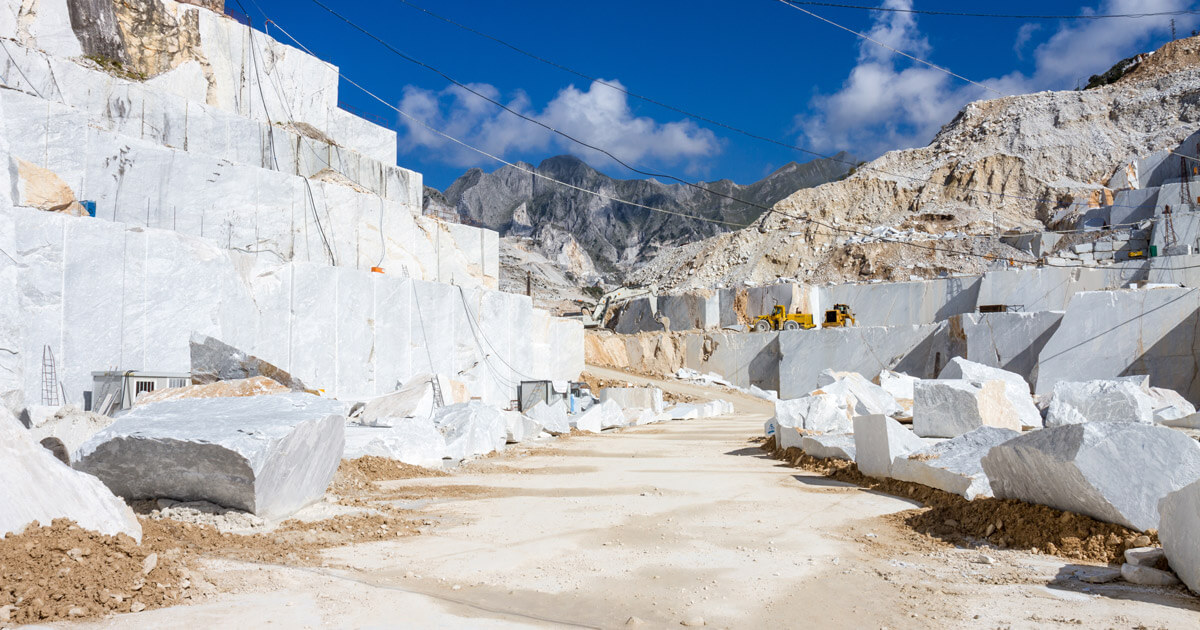
- Request Info
- Terms & Conds
- Private Tour
- Tour from Lucca
- Tour from Montecatini
- Tour from Pisa
- Tour from Viareggio, Lido di Camaiore, Forte dei Marmi
- Visit Tuscany
Discover the Fantastic Carrara Marble Quarries in Tuscany on a 4×4 Jeep
On our Carrara Marble Quarries Tour: 4×4 Off Road Trip in Tuscany, you will have the chance to visit the famous marble quarries in Carrara on board with a 4×4 off-road tour. Moreover, you will taste the delicious Lardo di Colonnata in the nearby village Colonnata.
The perfect Off-Road Tour Experience to the Carrara marble quarries in Tuscany with a delicious Tasting in Colonnata
Please, do not choose us if you like crowded tours.
From your Hotel or Accommodation directly to the Marble Quarries of Carrara
Our driver will pick you and your group up directly from your accommodation with our comfortable minivan. From there we will drive in direction of the mountain region of the Apuan Alps , where the Quarries of Marble of Carrara are located.
The Marble of Carrara in Tuscany
The famous Carrara Marble is well-known all over the world and many people choose this material to give a touch of luxury to their home kitchens and bathrooms. The so called Tuscan “white gold” and its extraction date back to the Roman times. The manufacturing of marble regards buildings and furnitures and in the past many artists used marble for artistic and architectural purposes. Many famous statues you can still see today come from the marble quarries located in this area. Indeed, even the famous Michelangelo used it to create the David . On our way to the Apuan Alps region, our guide will tell you about the history of this region and the evolution in the extraction methods during the centuries. You will learn about the marble basins and the different kinds of marble.
Read more about the Carrara marble .
Inside the Marble Quarries of Carrara on our Private Off Road Trip
Once we reach the Region of the Apuan Alps, we will get off our minivan and board a jeep, in order to start our 4×4 Off Road Tour in the Marble Quarries. The only way to visit them is with our authorized partner. In fact, the caves are anctive working place. For this reason, it is not possible to access this area on your own.
You will learn about the ancient and modern tecniques used to extract marble from the caves. On our jeep tour an expert will show us three different kinds of basins.
You will love the view over tha marble quarries and the white Apuan Alps.
Learn more about this area in our article .
Unique Scenery over Marble Quarries and Tuscany
During our Carrara Marble Quarries Tour: 4×4 Off Road Trip in Tuscany, you will enjoy an incredible view over the Apuan Alps and the marble caves. We will drive up to an altitude of 900 m. From there, the scenery will be breathtaking. The view is unique, with the Alps and the coast in the same picture. When people look at the Apuan Alps, they often think they are covered with snow. Hower, it is the big presence of marble quarries that make them white. You will enjoy a general overview of the active excavation basins with the trucks and bulldozers at work. A quarryman will tell you about the massive blocks of marble and give you information about this long tradition. You will notice how the white and bright marble basins are in contrast with the dark colours of the mountains around, when getting closer to the blocks.
Even the James Bond serie chose this background for its Quantum of Solace movie. Some scenes were shot in these quarries.
If you wish to buy some souvenirs , we can stop at few marble shops on our way to the quarries.
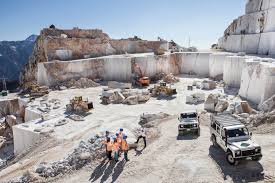
Colonnata, and “Lardo”on our Private Tour in Tuscany
Colonnata is a tiny village only few kilometres far from Carrara. It is located closed to the marble quarries and during the centuries the quarrymen and their families used to live here. This small village is well known in Italy and abroad for a delicious specialty called Lardo di Colonnata , a unique pork lard traditionally cured in the marble caves. During our tour, we will have a short break to taste it and enjoy its unique flavour.
Lard is made with pig fat, using the pig shoulder and neck. The pieces of lard are placed in large marble boxes and covered with sea salt, rosmary, garlic, local herbs and spices (pepper, cinnamon, nutmeg and cloves).To get its delicious taste, it has to stay and age there from a minimum of 6 months up to ten months.
Itinerary to the Carrara marble quarries in Tuscany:
Departure from your accommodation, arrival in quarries and start of the off-road tour, short break in colonnata, return to your accommodation.

Request More Info About Carrara Marble Tour: 4x4 Off Road in Marble Quarries
Full Name (required)
Your Email (required)
Tour Date (required)
N. Adults: 1 2 3 4 5 6 7 8
N. Childrens: —Please choose an option— 0 1 2 3 4 5 6 7
Age of child: —Please choose an option— 1 2 3 4 5 6 7 8 9 10 11 12 13 14 15 16 17
Age of child 1: —Please choose an option— 1 2 3 4 5 6 7 8 9 10 11 12 13 14 15 16 17 Age of child 2: —Please choose an option— 1 2 3 4 5 6 7 8 9 10 11 12 13 14 15 16 17
Age of child 1: —Please choose an option— 1 2 3 4 5 6 7 8 9 10 11 12 13 14 15 16 17 Age of child 2: —Please choose an option— 1 2 3 4 5 6 7 8 9 10 11 12 13 14 15 16 17 Age of child 3: —Please choose an option— 1 2 3 4 5 6 7 8 9 10 11 12 13 14 15 16 17
Age of child 1: —Please choose an option— 1 2 3 4 5 6 7 8 9 10 11 12 13 14 15 16 17 Age of child 2: —Please choose an option— 1 2 3 4 5 6 7 8 9 10 11 12 13 14 15 16 17 Age of child 3: —Please choose an option— 1 2 3 4 5 6 7 8 9 10 11 12 13 14 15 16 17 Age of child 4: —Please choose an option— 1 2 3 4 5 6 7 8 9 10 11 12 13 14 15 16 17
Age of child 1: —Please choose an option— 1 2 3 4 5 6 7 8 9 10 11 12 13 14 15 16 17 Age of child 2: —Please choose an option— 1 2 3 4 5 6 7 8 9 10 11 12 13 14 15 16 17 Age of child 3: —Please choose an option— 1 2 3 4 5 6 7 8 9 10 11 12 13 14 15 16 17 Age of child 4: —Please choose an option— 1 2 3 4 5 6 7 8 9 10 11 12 13 14 15 16 17 Age of child 5: —Please choose an option— 1 2 3 4 5 6 7 8 9 10 11 12 13 14 15 16 17
Age of child 1: —Please choose an option— 1 2 3 4 5 6 7 8 9 10 11 12 13 14 15 16 17 Age of child 2: —Please choose an option— 1 2 3 4 5 6 7 8 9 10 11 12 13 14 15 16 17 Age of child 3: —Please choose an option— 1 2 3 4 5 6 7 8 9 10 11 12 13 14 15 16 17 Age of child 4: —Please choose an option— 1 2 3 4 5 6 7 8 9 10 11 12 13 14 15 16 17 Age of child 5: —Please choose an option— 1 2 3 4 5 6 7 8 9 10 11 12 13 14 15 16 17 Age of child 6: —Please choose an option— 1 2 3 4 5 6 7 8 9 10 11 12 13 14 15 16 17
Age of child 1: —Please choose an option— 1 2 3 4 5 6 7 8 9 10 11 12 13 14 15 16 17 Age of child 2: —Please choose an option— 1 2 3 4 5 6 7 8 9 10 11 12 13 14 15 16 17 Age of child 3: —Please choose an option— 1 2 3 4 5 6 7 8 9 10 11 12 13 14 15 16 17 Age of child 4: —Please choose an option— 1 2 3 4 5 6 7 8 9 10 11 12 13 14 15 16 17 Age of child 5: —Please choose an option— 1 2 3 4 5 6 7 8 9 10 11 12 13 14 15 16 17 Age of child 6: —Please choose an option— 1 2 3 4 5 6 7 8 9 10 11 12 13 14 15 16 17 Age of child 7: —Please choose an option— 1 2 3 4 5 6 7 8 9 10 11 12 13 14 15 16 17
Your Requests and information about departure
Terms And Conditions
- Deposit 30% is required at reservation time, by credit card or paypal (in both case 4% more) in order to guarantee your reservation.
- Due payment may be made 15 days in advance by the same way or the day of tour in cash in Euro
- There will be a full charge to your deposit for bookings canceled less than 7 days prior or for no-shows.
- No charge for cancellations made with at least 7 days prior notice. If you are interested in proceeding we will send you the complete terms of service upon request.
- They can also be viewed on the website by clicking the TERMS AND CONDITIONS link at the bottom of any page.
Tour Reviews
There are no reviews yet.
Leave a Review
Cancel reply.
Save my name, email, and website in this browser for the next time I comment.
You May Also Like

Chianti Lovers Small Group Tour from Montecatini- 2 Wineries and SuperTuscan
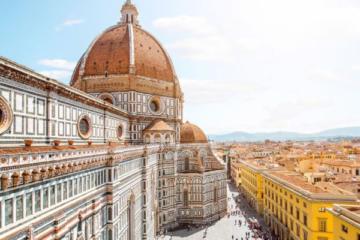
Florence and Uffizi or Accademia Museum Private Tour from Versilia
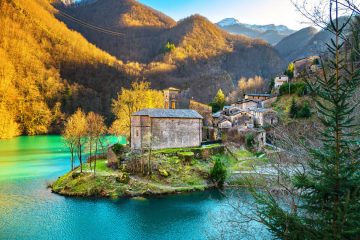
Tuscany Day Tour: Visit Lucca, Barga and Garfagnana Hills

- Kitchen Countertops
- Statues and Bas-Relief
- Decorative Borders
- Work with us
- Quarry Tour
THE MARBLE QUARRIES OF CARRARA
Marble has been used for centuries as an important material in architecture and stone-work. The Apuan Alps, located on the Italian Peninsula between Lucca to Florence contain vast deposits of marble which can be found especially at three main gullies: Torano Miseglia Colonnata
The experts estimated total excavation area is 67 km2 with 60 thousand million cubic meters volume making it one of the best stones around!
The history of marble production is long and complicated. It dates back over 2,000 years. The first major development was when early humans began cutting into rock with stone ages ago, which then led them to discover how much easier it is than working inside a rough environment like today’s mines due out of necessity rather than choice because there were no other options at hand for obtaining material needs that could not be met just by searching outside oneself so this made production much more efficient but also left behind evidence all over Europe especially Britain where some notable buildings still stand today such as Stonehenge.
- Excavation Of Marble
- TRANSPORTATION OF MARBLE
- MARBLE CUTTING
- VISITING THE MARBLE QUARRIES
- THE TOWN OF CARRARA
- CARRARA – THE CENTRE
- MUSEUM AND EVENTS
Need more info ? Contact us by WhatsApp We will reply to your request immediately.
Privacy overview.
Jeep Tour of Carrara Marble Quarries in Tuscany
See the Carrara Marble Quarries by Jeep
:max_bytes(150000):strip_icc():format(webp)/martha_bio-56a3c8865f9b58b7d0d3b5fe.jpg)
Carrara Marble Tour
The famous marble of Carrara has been quarried since Roman times and has long been a favorite of sculptors, including Michelangelo. Fantiscritti Marble Quarries, or cave (pronounced cah-vey ), has a 50 minute 4x4 jeep tour that gives visitors a chance to get an inside look at the quarries and also includes a fantastic view from high above them.
If you're in the Carrara area of northern Tuscany , don't miss this experience.
Inside the Marble Mines of Carrara
Carrara Marble Tour takes you on a fascinating ride through the quarries for a close look at the marble cliffs and mines. Near the top, you'll get out and enjoy a spectacular view of the quarries, the city of Carrara, and the coast. This is a much higher point than you are allowed to drive to on your own.
Your guide will explain the history and uses of marble, the different types of marble, and how the quarries operate. You'll see a working section of the mine, as well as the site where several Austin Martin's went over the cliff during the filming of the James Bond movie, Quantum of Solace .
The interesting and scenic 50-minute tour is offered daily from March to November and is priced at 12 euros (as of 2019). A 3-4 hour option includes pick-up and drop-off from your nearby hotel, time to tour the town of Carrara, plus a special breakfast of local specialties, including lardo di Colonnata, which is seasoned pork fat. This tour is currently priced at 65 euros per person.
Carrara Marble Tour Details
- Cave di Fantiscritti Carrara Marble Tour . Check the website for updated hours and prices or to book a tour.
- The cost is 12 euros (as of 2019).
- Tours are 50 minutes and can be taken in Italian, English, or French.
- Note that during inclement weather, the mines are not in operation.
- At the parking area of the quarry are a museum, gift shop, restaurant, and restrooms. In summer, there are mini-bus tours inside the mines.
- From Carrara, follow signs for Cave and then Fantiscritti, going through a couple of marble tunnels.
If you have a car, it's possible to see some of the mining areas and visit the museum without taking a tour, although the tour is a highly recommended way to see the quarries close-up and is worth the price just for the amazing views.
Sightseeing Near the Carrara Marble Quarries
Very near the marble quarries is the picturesque mining town of Colonnata, famous for producing lardo . Colonnata is a good place to eat with several restaurant choices.
Carrara is in the part of northern Tuscany known as Versilia that includes the three main towns of Carrara, Massa, and Pietrasanta and a long stretch of coast where you'll find beaches and the seaside resort town of Viareggio , famous for its carnival parades.
Tuscany Off the Beaten Path Away from Tourist Crowds
Capri Italy Guide: Planning Your Visit
Where to Go on Italy's Mediterranean Coast
20 Best Things to Do in Florence, Italy
Pietrasanta, Italy Travel Guide
Florence Italy Travel Guide
A Travel Guide for Italy's Forte dei Marmi
The 9 Best Beaches and Coastal Areas in Tuscany
The 14 Best Day Trips from Rome
Italian Nativity Displays and Christmas Scenes
Explore Italy's Caverns and Grottoes
How to Visit the Vatican Museums and Sistine Chapel in Rome
Your Trip to Florence: The Complete Guide
Siena Guide: Planning Your Trip
The Top 10 Day Trips from Naples, Italy
The Top Neighborhoods to Explore in Florence, Italy
Inside Italy's coveted marble quarries where artists like Michelangelo traveled for the finest materials
- I visited an active quarry in the Apuan Alps of Carrara, Italy — home to the coveted Carrara marble.
- Located in Tuscany, Carrara marble is a $1 billion industry thanks to hard workers at the quarries.
- One huge slab of marble takes five days to cut and remove from the mountain range.
From far away, the Apuan Alps in Carrara, Italy, look snowcapped. But they're actually covered in white marble.
"Is that snow?" my partner said one morning during a summer Mediterranean cruise as we opened our cabin's curtains to see a wide view of the Apuan Alps in Carrara, Italy .
"No, it's marble," I said, smiling, because if I hadn't done my research, I would have thought the same thing.
The mountain range is home to the marble basin of Carrara in Tuscany. The marble in the Apuan Alps has been used since the Roman Empire for buildings and sculptures, according to UNESCO .
Today, it's home to several marble quarries, and I got to see them for myself.
The mountain range is home to some of the most coveted marble in the world, and it's dotted with marble quarries. I recently got a closer look during a group tour.
For my Mediterranean cruise last month, I booked an excursion with Carrara Marble Tour to see the mountain range lined with marble quarries up close.
During the tour, I learned that Carrara is among the most coveted marble in the world, and the guide explained exactly why.
"The marble from Greece and China has very big crystals. It's too hard," he said. "The marble from Turkey has very small crystals. So it's easier to work with, but it's too fragile. Carrara is the right compromise."
Although it's easier to work with than other forms of marble, another reason the material is so coveted is because of all the time and effort that goes into cutting it and transporting it from the mountain range to countries around the world, he said.
The mountain range also has preservation methods in place limiting the amount of marble that can be taken from it, he added.
The Apuan Alps are in Tuscany, Italy.
The Apuan Alps in northwest Tuscany spread over 150 miles, including the province of Carrara, according to UNESCO.
Before the tour, I learned that Michelangelo used Carrara marble to create his famous David statue.
Before my cruise, I did some research about Carrara marble and learned that Michelangelo used the coveted material to make some of his sculptures, including the famous Apollo-David statue, according to the Metropolitan Museum of Art .
Michelangelo spent his time in Carrara choosing specific cuts of marble from the quarries with custom orders about their sizes and shapes, according to the same source.
With this information, I was excited to see the historic marble for myself.
Today, Carrara marble is a $1 billion industry that produces products from tiles and countertops to toothpaste.
The Carrara marble industry is worth $1 billion and a slab can cost up to $400 per square meter, Business Insider reported in 2019.
More recently, Italics Magazine reported that the industry made about $22 million in the first three months of 2022.
Our tour guide said that the marble is cut into different sizes and is used for a wide variety of products, including countertops, tiles, and even toothpaste.
My tour started at 9 a.m. when our guide picked us up from a dock in Carrara and drove us through the town to the marble mountain range.
When my cruise ship stopped in Carrara, I disembarked at 9 a.m. to meet my tour group at the dock, where our tour guide picked us up in a 4x4 jeep.
Then we drove up windy, cliffside roads and saw open-air quarries along the way.
As we ascended the mountain, we saw open-air active quarries lining the mountain cliffs. There are 30 of them on this road, according to my tour guide.
Before visiting the quarries, we stopped at the tour center's home base and picked up helmets and vests for safety.
Part of the way through the trip, we stopped at the tour center's gift shop, where we borrowed orange vests and yellow hard hats to keep us safe at the quarries.
The tour's website also suggests wearing comfortable shoes. I wore a pair of Vans sneakers and had no problem walking around the quarry in them.
Once we geared up, we headed to one of the many open-air marble quarries to see how it's cut and transported down the mountains.
As soon as we got out of the car at one of the quarries, I knew that this mountain range was unlike any I'd been to before just by the sounds.
Typically, hiking through mountains is a relatively quiet experience, save for the whispering wind, chirping birds, and my boots hitting the ground. But in the Apuan Alps, I heard the constant beeps and mechanical sounds of drilling all around me.
Cutting one giant slab of marble takes about five days. The first four days are spent cutting the slab out of the mountain.
Cutting one huge piece of marble takes about four days, our tour guide said. And then he explained exactly how the marble is cut and transported.
First, workers use a machine to stab into the marble and cut the bottom portion of the slab. At this quarry, the first cut usually is about 50 feet long and 10 feet deep.
Then, they use a drilling machine to make a vertical hole from the top of the slab to the bottom of the slab. These two cuts take two days.
Then they repeat the process on the other side of the slab over the next two days.
On day five, workers remove the slab from the mountain.
Once the marble is cut on all sides, workers insert a long, metal cable into the holes in the marble and use machines to pull it off of the mountain.
The perfect slab weighs 35 tons and has no cracks, the tour guide said.
From there, machinery moves the slab onto the bed of a truck to be driven down the mountain and transported around the world.
Once the marble is cut out of the mountain, workers place a soft, sand cushion on the bottom of a truck bed to protect the marble. Then, they hook the slab to a machine that lowers it onto the truck bed. The truck drives down the mountain for the marble to be transported.
Carrara marble is sent around the world, from Rome to Beijing, The New York Times reported .
I was surprised and mesmerized by the amount of time and work that goes into cutting and transporting just one slab of marble. And that helped me understand why it's so valuable.
The work that goes on at the marble quarries seems like a very challenging task, in my opinion. After seeing it for myself, I understood what our guide meant when he said this material is so coveted.
I'm not at a place in my life where I can afford the luxuries of Carrara marble in my kitchen . But one day, I hope to own some for myself. And I'll have a sincere appreciation for the work that went into it.
- Main content
A visit to the Carrara marble quarries
By toni brancatisano | June 1, 2021
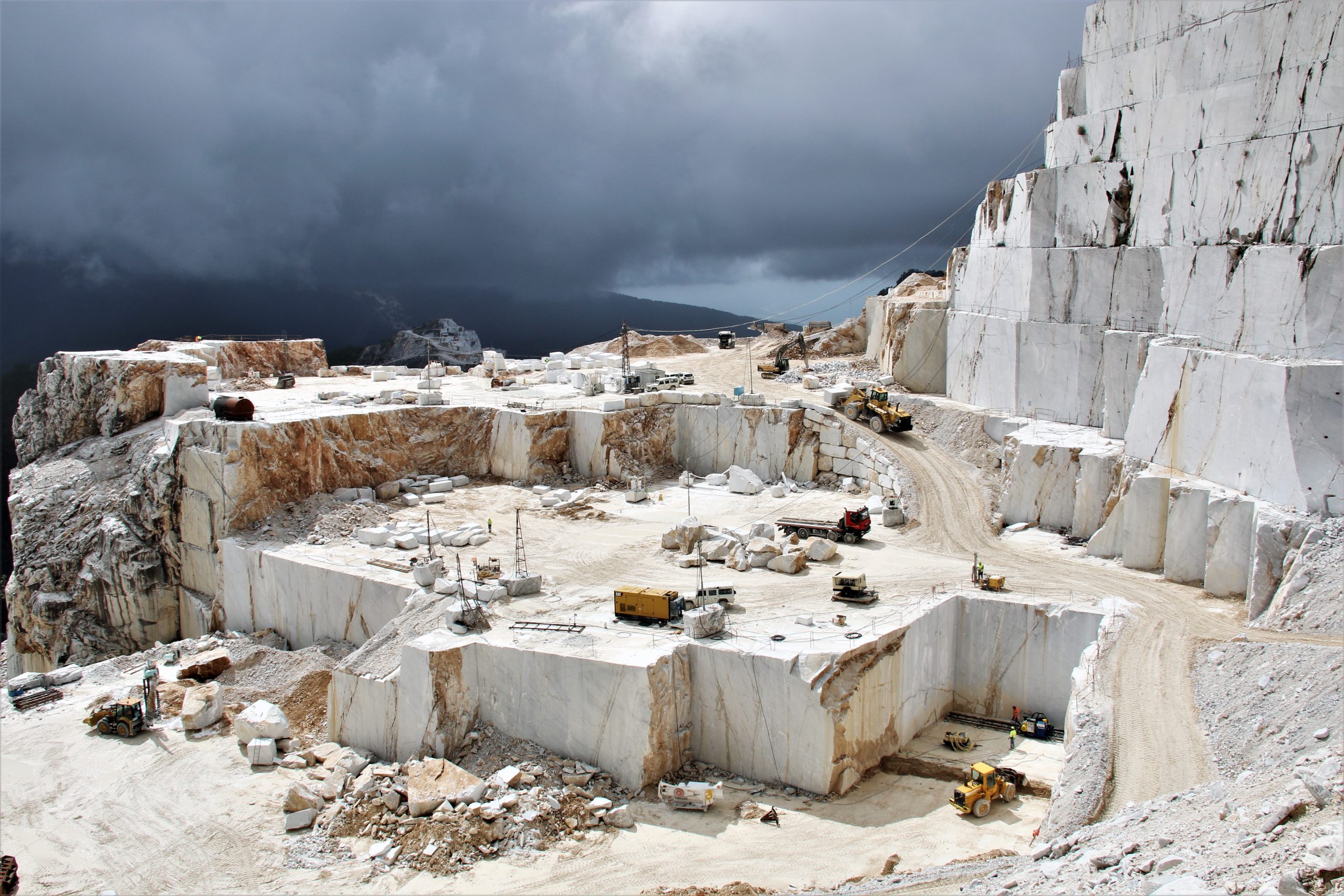
Tours – Carrara Marble Tour
If you happen to find yourself lying on one of the beautiful beaches along the Versilian coast in northern Tuscany, it would be impossible not to admire the majestic Apuan Alps . It would be easy to think that the stark white surfaces on the upper heights is snow and many have made this mistake, despite the scorching summer temperatures on the beach.
It is indeed remarkable to think that this is the origin of some of the most beautiful marble finishes that decorate churches, cathedrals, famous marble sculptures or, quite simply, the marble sitting in kitchens and bathrooms all around the world. The name “ white Carrara marble ” has become like a brand, synonymous with high end luxury décor, buildings and furnishings.
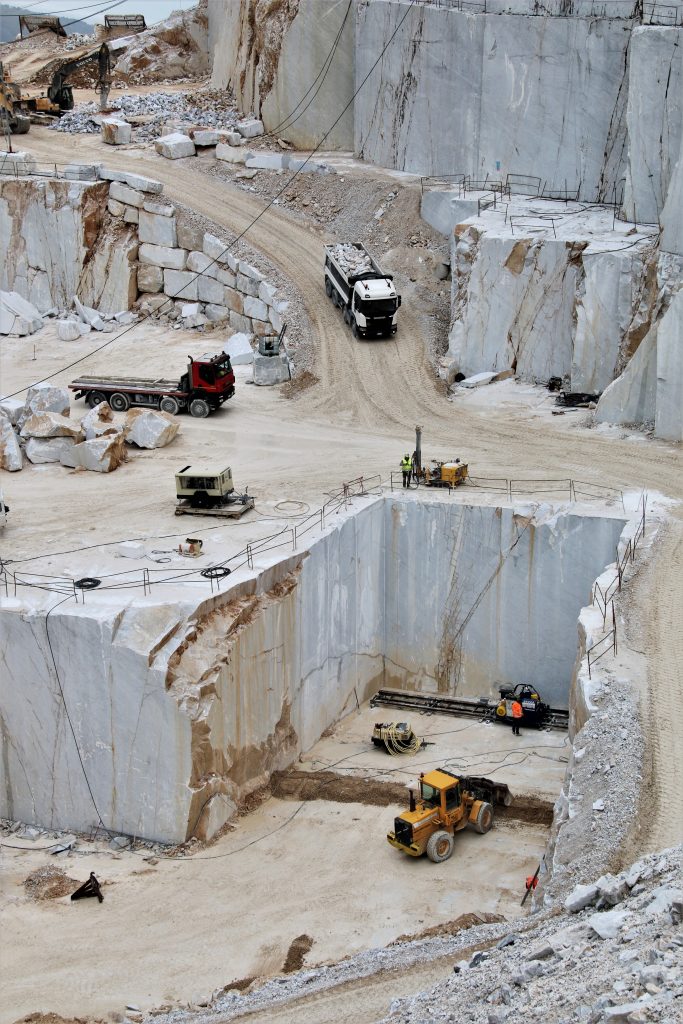
White Carrara marble has maintained its prestige for thousands of years; it was two thousand years ago that the ancient Romans first removed the layer of trees and grassy carpet that dressed the mountains to reveal the precious white stone laying underneath. The Romans took possession of Carrara and its surroundings (once named Luni ) and the Alps in 180 BC, after winning the territory from a Celtic population that had settled in the area. Carrara marble supplied the Roman Empire for the construction of many famous monuments that tourists admire today. The Pantheon and the Trajan’s Column in Rome are built of Carrara marble, as is the Portico di Ottavia . Emperor Augustus is known to have said boastingly, “ I found Rome a city of bricks and left it a city of marble .”
Many sculptures of the Renaissance (Michelangelo’s David to name one) were also carved in marble from Carrara. Michelangelo is known to have visited many times during his lifetime (he lived into his 90s) and each time he stayed in the area for at least 4-5 months to search for and find the perfect block of marble to use for his sculptures. Michelangelo required the pure white Statuario di Carrara marble, which is characterized by its pure milk-white colour, that makes it very valuable. The first time Michelangelo visited the Apuan Alps was when he was looking for the perfect marble to use to sculpt the Vatican Pietà – the only piece of sculpture Michelangelo ever signed, which is now housed inside St. Peter’s Basilica, in Rome. It is a beautiful piece of art, depicting the Virgin Mary cradling the dead body of her son Jesus, something that really has to be seen when visiting Rome. After visiting the Apuan Alps repeatedly, Michelangelo fantasized about carving the whole peak of the mountain to create a sculpture so colossal that the passing ships would be able to see it from the sea.
Statuario marble is very rare, and there is only one point today on the Apuan Alps where this prestigious type of marble is available, or where it is allowed to be excavated. This limited amount must satisfy the needs of the entire planet – and this is what pushes the price up and gives this type of marble the nickname oro bianco (white gold). Pure white statuario marble is soft in comparison to marble that has grey or black veins running through it. The whiter the marble, the more calcium carbonate is present. The grey veins are caused by carbon and some impurities and the more that is present, the harder the marble stone.
Once upon a time the extraction of the marble was entrusted to slavery, and their techniques remained unchanged for thousands of years. In the beginning, the miners exploited the natural fissures of the rock, and inserted wooden wedges. These were then wet with water: their swelling, caused by the natural expansion of the wood, ,would cause the marble block to detach from the mountain. The Romans used metal chisels to cut blocks with a depth of about 2 meters. Metallic chisels were inserted into cuts about 20cm (around 9 in) deep, and after much continuous hammering, the block was separated from the mountain. Then, to cut the block into smaller slabs, two men would use a large handsaw while a mixture of water and silica was poured onto the block to facilitate the cutting process. It’s incredible to think that, each day, only about 8cm would be cut, and it could take up to two years from extracting the marble to transporting it to the coast.
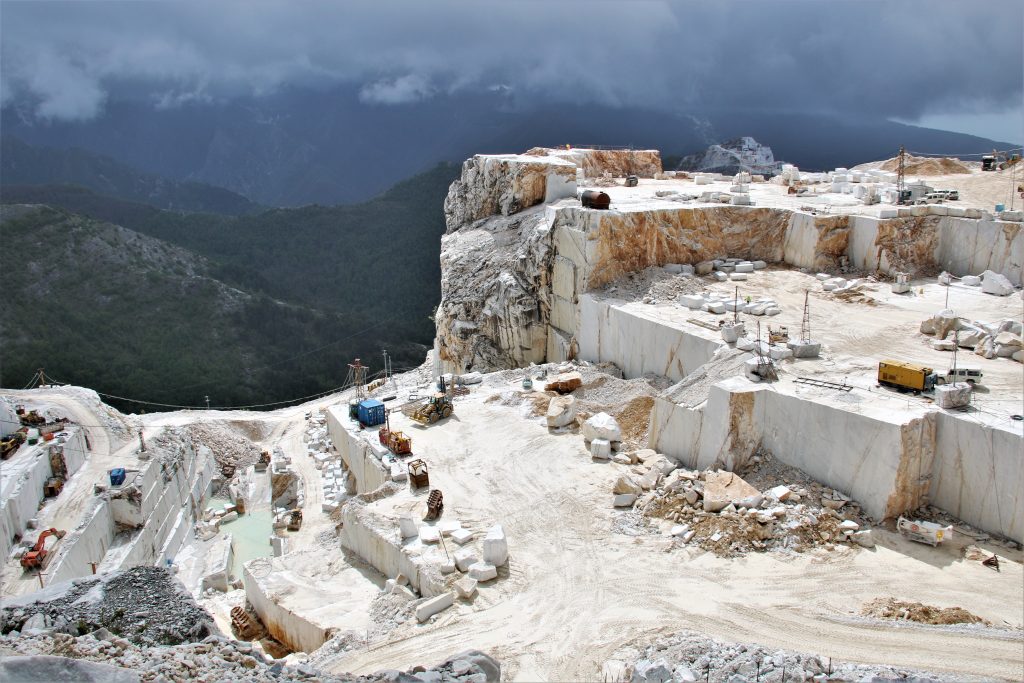
During the 18 th century , explosions were used to extract the marble, but this method was aborted pretty quickly after it was realised that the damage to the Apuan Alps was great and too much waste was created.
Once the marble blocks were cut away from the mountain, another challenge lay ahead: how to transport the marble down the mountain, to the sea port. One of the most dangerous jobs in working in the marble quarries was to be involved in the transport. The marble blocks weighing about 30 tons had to be carefully transported down very steep slopes on a sleigh-type structure that would slide on wooden beams greased with soap. Ropes were used by about 10-12 men to try and control the marble and to resist the pull of gravity. Two other men had the job of transferring the beams from the back to the front and you can imagine how often accidents happened: many men were killed. Oxen were also used and the work was so strenuous for them that often they would die along the way. There are wonderful black and white photographs documenting these powerful beasts hauling blocks of marble down to the sea port, onto the pier where they would be loaded on ships.
Transporting the marble down the mountain is still a very dangerous job and requires skilled driving of heavy trucks. Even just watching these huge machines manoeuvre down the mountain and execute 3 point turns to get around some of the sharp turns can provoke anxiety! There are sprinklers operating along the roads, keeping the ground wet. This is important to stop the trucks tyres slipping on dry gravel as they come down the mountain carrying the large marble blocks.
When one visits the Carrara marble quarries , the appreciation for the work and workers that contribute to each stage of the journey, from the mountain to the finished product, can be fully understood. In the Carrara marble basin, there are three areas designated to quarries, they are the known as the Torano , Colonnata and Fantiscritti quarries. I visited the Fantiscritti quarries and they are the most famous of the once existing Roman city of Luni. I booked a tour with Carrara Marble Tour company and our guide Davide was a wealth of knowledge.
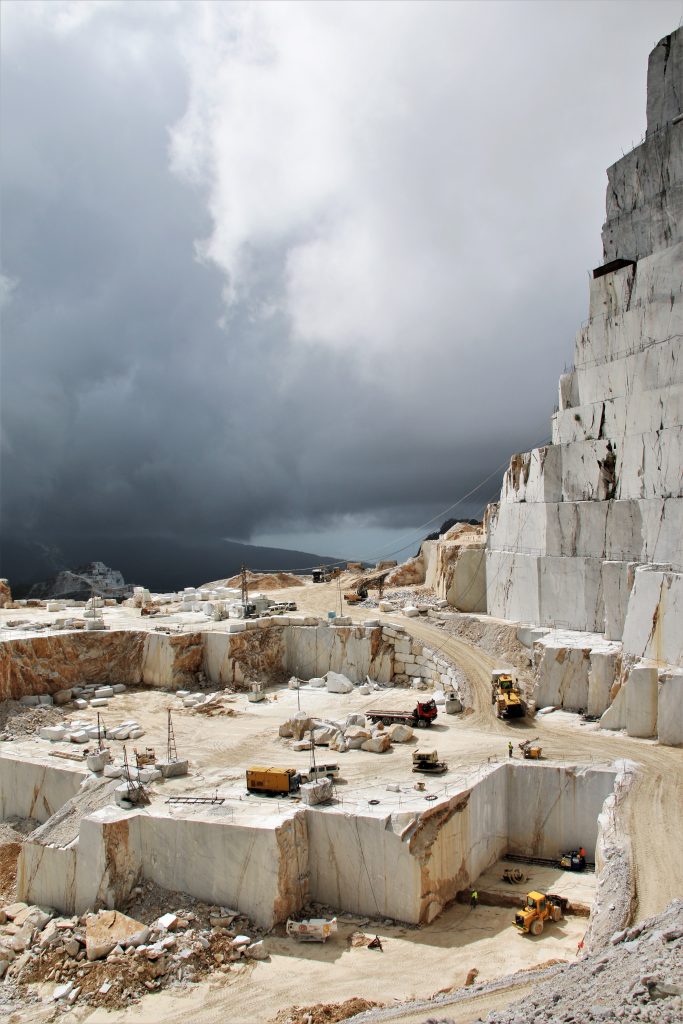
Davide told of another group of men who work on the Apuan Alps and play an important and integral role, alongside that of the quarrymen. These men are required to listen to the sounds of the mountain, and to detect and prevent danger. They have one of the oldest and most demanding, yet fascinating professions in the world. They are called the tecchiaioli , also nicknamed ragni bianchi (white spiders) and they are the unsung guardian angels of the quarrymen. They work in extreme conditions to provide safety of other workers.
They work in the Apuan marble quarries to monitor and clean the quarry front (the tecchia , in the Carrarese dialect) to eliminate any unsafe boulders, or sheets of marble that could potentially cause injuries (or death) if they were to fall on the unsuspecting quarrymen working below. Until the 1990s, it was the same quarrymen who descended into the overhangs harnessed to a rudimentary hemp rope. Now, professional rock climbers do it with the same techniques and equipment used in mountaineering and caving. They go from quarry to quarry, stopping for two or three months at a time to secure the rocky face.
The tecchiaioli move along the walls of the Apuan Alps and remain suspended for hours on the white chasms of the marble quarries. They listen to the mountain, observe it, take care of it, silently and meticulously getting the job done, just like hanging spiders.
Very few know of the existence of this figure, thetecchiaiolo. Many people assume the quarrymen have the hardest jobs, but few know of the harsh and exhausting conditions of tecchiaioli, who face risk, fatigue, and sometimes even fear daily. Their white surroundings are the breathtaking scenery of the quarries, yet they work in the most extreme conditions and weather: heat, cold, and wind. Every day, all year round, hanging, immersed in the blinding white of the marble. They are a tight-nit team, and the responsibility on their shoulders is great, so this means it’s also a job that causes great stress on a daily basis.
During the mining process, the shape of the mountainous peaks and the marble façade are continuously modified and the aesthetics of the Alps can change brutally in a matter of weeks: in a few hours walls of tens of meters can disappear. One thing people may not consider is that extracting marble blocks from the mountain causes much wasted marble. Sometimes the blocks shatter as they fall and, once upon a time, all this marble “rubble” created problems as it accumulated in the valleys below.
Today, marble waste is utilised in many industries. The bits that have broken off, blocks that have shattered, or the cut-offs created when cutting a perfect block of marble, can be made into small stones that are used for paving or they are ground to make marble dust. This dust of calcium carbonate is used in toothpaste, soaps, cosmetics, paper production, cement production, to make glue, etc. Nothing is wasted anymore.
This “recycling” has only been taking place since 1980 and, before that, the three Carrara marble basins were submerged in 2000 years of accumulated marble waste. This was a huge issue because it had covered areas where there was good quality marble that could be mined. This “problem” has now become a valuable resource, especially if you consider that from a productive quarry, about 40% of the marble extracted becomes waste, with some quarries reaching 80% .
Seeing the quarries for the first time close up can be quite shocking – they seem like a giant wound in the mountain. We were at 1000m above sea level, but the mountains rise to about 1700m – 1800m and it’s important to realise that they are all marble. It has been calculated that the marble extends also to at least 2 km below sea level, so although it seems shocking that marble has been taken from the Apuan Alps for so long, there is still plenty to last for at least the next 500 years.
Two thousand years passed where there wasn’t any regulation on the number of quarries created or the amount of marble extracted. One could cut what they wanted, use explosives and not face any consequences. Today the whole process must abide by strict laws. Every two years, every company that manages a marble quarry must produce a plan to the region of Tuscany where they must detail exactly how many metres they plan to excavate. The environmental impact, the stability of the mountains and the estimated waste is evaluated before they receive authorisation to proceed.
The Apuan Alps are now protected by UNESCO, (The United Nations Educational, Scientific and Cultural Organization) and the regulation of mining is so strict today, there is no talk whatsoever of creating new quarries other than the ones that already exist.
If you do find yourself in northern Tuscany, take the time to visit the Carrara marble quarries and book a tour with CARRARA MARBLE TOUR company. It will definitely make you appreciate so much more when you see white Carrara marble anywhere around the world.
**CARRARA MARBLE TOUR Tours – Carrara Marble Tour company also organise private customised tours that can include a visit to the quarries, the marble museum, followed by lunch and tasting of traditional regional recipes including the famous lardo di Colonnata .
Se vi capita di trovarvi sdraiati su una delle belle spiagge lungo la costa versiliese nel nord della Toscana, sarà impossibile non ammirare le maestose Alpi Apuane. Sarebbe facile pensare che le superfici bianche sulle montagne più alte siano neve e molti fannp questo errore, nonostante le torride temperature estive sulla spiaggia. È davvero notevole pensare che questa sia l’origine di alcune delle più belle finiture di marmo che decorano chiese, cattedrali, famose sculture di marmo o, semplicemente, il marmo che si trova nelle cucine e nei bagni di tutto il mondo. Il nome “marmo bianco di Carrara” è diventato un marchio, sinonimo di arredamento di lusso e di edifici e mobile di alta gamma. Il marmo bianco di Carrara ha mantenuto il suo prestigio per migliaia di anni; fu duemila anni fa che gli antichi Romani rimossero per la prima volta lo strato di alberi e il tappeto erboso che vestiva le montagne per rivelare la preziosa pietra bianca che giaceva sotto. I Romani presero possesso di Carrara e dei suoi dintorni (un tempo chiamati Luni) e delle Alpi nel 180 a.C., dopo aver conquistato il territorio di una popolazione celtica che si era stabilita nella zona. Il marmo di Carrara rifornì l’impero romano per la costruzione di molti monumenti famosi che i turisti ammirano oggi. Il Pantheon e la Colonna Traiana a Roma sono costruiti in marmo di Carrara, così come il Portico di Ottavia. L’imperatore Augusto è noto per aver detto con orgoglio: “Ho trovato Roma una città di mattoni e l’ho lasciata una città di marmo”. Anche molte sculture del Rinascimento (il David di Michelangelo per citarne una) furono scolpite in marmo di Carrara. Michelangelo è noto per aver visitato le cave molte volte durante la sua vita (visse fino a 90 anni) e ogni volta rimaneva nella zona per almeno 4-5 mesi per cercare e trovare il perfetto blocco di marmo da usare per le sue sculture. Michelangelo richiedeva il marmo bianco puro Statuario di Carrara, che è caratterizzato dal colore bianco latte puro, che lo rende molto prezioso. La prima volta che Michelangelo visitò le Alpi Apuane fu quando stava cercando il marmo perfetto da usare per scolpire la Pietà vaticana – l’unica scultura che Michelangelo abbia mai firmato, che ora si trova all’interno della Basilica di San Pietro, a Roma. Si tratta di una bellissima opera d’arte, raffigurante la Vergine Maria che culla il corpo morto di suo figlio Gesù, un’opera che deve davvero essere vista quando si visita Roma. Dopo aver visitato ripetutamente le Alpi Apuane, Michelangelo fantasticò di scolpire l’intera cima della montagna per creare una scultura così colossale che le navi di passaggio sarebbero state in grado di vederla dal mare. Il marmo Statuario è molto raro, e c’è solo un punto oggi sulle Alpi Apuane dove questo prestigioso tipo di marmo è disponibile, o dove è permesso scavarlo. Questa quantità limitata deve soddisfare il fabbisogno dell’intero pianeta – e questo è ciò che spinge in alto il prezzo e dà a questo tipo di marmo il soprannome di oro bianco. Il marmo statuario bianco puro è morbido in confronto al marmo che ha venature grigie o nere che lo attraversano. Più bianco è il marmo, più è presente carbonato di calcio. Le venature grigie sono causate dal carbonio e da alcune impurità e più queste sono presenti, più dura è la pietra di marmo. Un tempo l’estrazione del marmo era affidata alla schiavitù, e le loro tecniche sono rimaste immutate per migliaia di anni. All’inizio, i minatori sfruttavano le fessure naturali della roccia e inserivano dei cunei di legno. Questi venivano poi bagnati con acqua: il loro rigonfiamento, causato dall’espansione naturale del legno, causava il distacco del blocco di marmo dalla montagna. I Romani usavano scalpelli metallici per tagliare i blocchi con una profondità di circa 2 metri. Gli scalpelli metallici venivano inseriti in tagli profondi circa 20 cm (circa 9 pollici), e dopo molte martellate continue, il blocco si separava dalla montagna. Poi, per tagliare il blocco in lastre più piccole, due uomini usavano una grande sega a mano mentre una miscela di acqua e silice veniva versata sul blocco per facilitare il processo di taglio. È incredibile pensare che ogni giorno venivano tagliati solo 8 cm circa e che potevano passare fino a due anni dall’estrazione del marmo al trasporto sulla costa. Durante il XVIII secolo, per estrarre il marmo si usavano le esplosioni, ma questo metodo fu eliminato abbastanza rapidamente dopo che ci si rese conto che il danno alle Alpi Apuane era grande e si creavano troppi scarti. Una volta che i blocchi di marmo erano stati tagliati dalla montagna, si presentava un’altra sfida: come trasportare il marmo giù per la montagna, fino al porto marittimo. Uno dei lavori più pericolosi nel lavoro nelle cave di marmo era relativo al trasporto. I blocchi di marmo del peso di circa 30 tonnellate dovevano essere trasportati con cura giù per pendii molto ripidi su una struttura tipo slitta che scorreva su travi di legno insaponate. Venivano tirate corde da circa 10-12 uomini per cercare di controllare il marmo e resistere alla forza di gravità. Altri due uomini avevano il compito di trasferire le travi dalla parte posteriore a quella anteriore e si può immaginare quanto spesso accadevano incidenti: molti uomini rimanevano uccisi. Venivano usati anche i buoi e per loro il lavoro era così faticoso che spesso morivano lungo la strada. Ci sono meravigliose fotografie in bianco e nero che documentano queste potenti bestie che trasportano blocchi di marmo fino al porto marittimo, sul molo dove sarebbero stati caricati sulle navi. Il trasporto del marmo giù per la montagna è ancora un lavoro molto pericoloso e richiede una guida esperta dei camion pesanti. Anche solo guardare queste enormi macchine manovrare giù per la montagna ed eseguire curve molto strette per aggirare alcuni tornanti può provocare ansia! Ci sono irrigatori in funzione lungo le strade, per mantenere il terreno bagnato. Questo è importante per evitare che i pneumatici dei camion scivolino sulla ghiaia asciutta mentre scendono dalla montagna trasportando i grandi blocchi di marmo. Solo quando si visitano le cave di marmo di Carrara, l’apprezzamento per il lavoro e i lavoratori che contribuiscono ad ogni fase del viaggio, dalla montagna al prodotto finito, può essere pienamente compreso. Nel bacino del marmo di Carrara, ci sono tre aree destinate alle cave, conosciute come le cave di Torano, Colonnata e Fantiscritti. Ho visitato le cave di Fantiscritti e sono le più famose della città romana di Luni, un tempo esistente. Ho prenotato un tour con la compagnia Carrara Marble Tour e la nostra guida Davide era un pozzo di conoscenza. Davide ha raccontato di un altro gruppo di uomini che lavorano sulle Alpi Apuane e svolgono un ruolo importante e fondamentale, accanto a quello dei cavatori. Questi uomini sono tenuti ad ascoltare i suoni della montagna e a individuare e prevenire i pericoli. Fanno uno dei mestieri più antichi e impegnativi, ma allo stesso tempo affascinanti, del mondo. Sono chiamati tecchiaioli, soprannominati anche ragni bianchi, e sono gli angeli custodi non celebrati dei cavatori. Lavorano in condizioni estreme per garantire la sicurezza degli altri lavoratori. Lavorano nelle cave di marmo apuane per monitorare e pulire il fronte di cava (la tecchia, in dialetto carrarese) per eliminare eventuali massi pericolanti, o lastre di marmo che potrebbero potenzialmente causare ferite (o morti) se dovessero cadere sugli ignari cavatori che lavorano sotto. Fino agli anni ’90, erano gli stessi cavatori a scendere negli strapiombi imbragati ad una rudimentale corda di canapa. Ora, gli scalatori professionisti lo fanno con le stesse tecniche e attrezzature usate nell’alpinismo e nella speleologia. Vanno di cava in cava, fermandosi per due o tre mesi alla volta per mettere in sicurezza la parete rocciosa. I tecchiaioli si muovono lungo le pareti delle Alpi Apuane e rimangono sospesi per ore sulle bianche voragini delle cave di marmo. Ascoltano la montagna, la osservano, se ne prendono cura, in silenzio e con meticolosità, proprio come dei ragni appesi. Pochi sanno dell’esistenza di questa figura, il tecchiaiolo. Molti danno per scontato che i cavatori facciano i lavori più duri, ma pochi conoscono le condizioni dure ed estenuanti dei tecchiaioli, che affrontano quotidianamente il rischio, la fatica e a volte anche la paura. Il loro ambiente bianco è lo scenario mozzafiato delle cave, eppure lavorano nelle condizioni e con il meteo più estremi: caldo, freddo e vento. Ogni giorno, tutto l’anno, appesi, immersi nel bianco accecante del marmo. Sono una squadra affiatata, e la responsabilità sulle loro spalle è grande, quindi è anche un lavoro che provoca grande stress quotidiano. Durante il processo di estrazione, la forma delle cime montuose e la facciata di marmo vengono continuamente modificate e l’estetica delle Alpi può cambiare brutalmente nel giro di settimane: in poche ore possono scomparire muri di decine di metri. Una cosa che la gente forse non considera è che l’estrazione dei blocchi di marmo dalla montagna causa molto spreco di marmo. A volte i blocchi si frantumano cadendo e, un tempo, tutte queste “macerie” di marmo creavano problemi accumulandosi nelle valli sottostanti. Oggi, i rifiuti di marmo sono utilizzati in molte industrie. I pezzi che si sono rotti, i blocchi che si sono frantumati, o gli scarti che si creano quando si taglia un blocco perfetto di marmo, possono essere trasformati in piccole pietre che vengono utilizzate per la pavimentazione o vengono macinate per fare polvere di marmo. Questa polvere di carbonato di calcio si usa nel dentifricio, nei saponi, nei cosmetici, nella produzione di carta, di cemento, per fare la colla, ecc. Non si spreca più nulla. Questo “riciclaggio” avviene solo dal 1980 e, prima di allora, i tre bacini di marmo di Carrara erano sommersi da 2000 anni di rifiuti di marmo accumulati. Questo era un problema enorme perché aveva coperto aree dove c’era marmo di buona qualità che poteva essere estratto. Questo “problema” è ora diventato una risorsa preziosa, soprattutto se si considera che da una cava produttiva, circa il 40% del marmo estratto diventa scarto, con alcune cave che arrivano all’80%. Vedere da vicino le cave per la prima volta può essere abbastanza scioccante: sembrano una gigantesca ferita nella montagna. Eravamo a 1000 metri sopra il livello del mare, ma le montagne salgono fino a circa 1700-1800 metri ed è importante rendersi conto che sono tutte di marmo. È stato calcolato che il marmo si estenda anche ad almeno 2 km sotto il livello del mare, quindi anche se sembra scioccante che il marmo sia stato prelevato dalle Alpi Apuane per così tanto tempo, ce n’è ancora in abbondanza per durare almeno per i prossimi 500 anni. Sono passati duemila anni in cui non c’era nessuna regolamentazione sul numero di cave create o sulla quantità di marmo estratto. Si poteva tagliare quello che si voleva, usare esplosivi e non affrontare alcuna conseguenza. Oggi l’intero processo deve rispettare leggi severe. Ogni due anni, ogni azienda che gestisce una cava di marmo deve fornire un piano alla regione Toscana in cui deve dettagliare esattamente quanti metri intende scavare. L’impatto ambientale, la stabilità delle montagne e gli scarti stimati vengono valutati prima di ricevere l’autorizzazione a procedere. Le Alpi Apuane sono ora protette dall’UNESCO (Organizzazione delle Nazioni Unite per l’Educazione, la Scienza e la Cultura) e la regolamentazione delle miniere è oggi così severa che non si parla di creare nuove cave oltre a quelle già esistenti. Se vi trovate nel nord della Toscana, prendetevi il tempo di visitare le cave di marmo di Carrara e prenotate un tour con la compagnia CARRARA MARBLE TOUR. Vi farà sicuramente apprezzare molto di più quando vedrete il marmo bianco di Carrara ovunque nel mondo. **CARRARA MARBLE TOUR Tours – L’azienda Carrara Marble Tour organizza anche tour privati personalizzati che possono includere una visita alle cave, il museo del marmo, seguito da un pranzo con degustazione di ricette tradizionali regionali tra cui il famoso lardo di Colonnata.

26 issues of L’Italo Americano digital edition
Support L’Italo Americano
If you’re able to, please support L’Italo Americano today from as little as $1.

Weekly Newsletter

COMMENTS
When you think of Carrara, your mind immediately goes to the Carrara marble quarry.. Carrara marble quarries are huge white wounds that open along the sides of the Apuan Alps: a fascinating orographic complex that has been declared a UNESCO World Heritage Site since 2015.. A unique territory, a succession of changing and fascinating landscapes, dominated by the mountain profiles of the marble ...
PRIVATE tour in Carrara marble quarries with 4x4 vehicles. 196. 4WD Tours. from . $381.85. per group (up to 8) LIKELY TO SELL OUT* Carrara: Exclusive Marble Cave Tour Adventure in a 4x4. 52. 4WD Tours. from . $81.82. ... Search the Web for Carrara Marble Tour (one word). Italy's Web extension is IT. There is a link on TripAdvisor for "Carrara ...
The tour includes. 4X4 off road vehicle up to 8 seats (+driver) - spoken languages: ITA /ENG. 50-minute tour of the marble quarries above Carrara. Rates. 15,00 € for person. 7,50 € for children up to age 6. The Quarryman Breakfast. Try the special "Quarryman Breakfast" at the restaurant Il Poggio (on reservation), experiencing the ...
Carrara Marble Quarry Private Tours. 5 ⭐ / 3 📝. 4. private tour. 🚙. 🥓. 100€/per. Note: following Covid restrictions some tours that included Colonnata's lard tasting, have now removed it from their tour. Remember to ask for confirmation for the tasting to be included, if that's important for you.
Carrara Marble Tour (50 minute 4x4 jeep tour) Carrara Marble Tour: 50 Minute tour of the marble caves and mines above Carrara. Cave di Fantiscritti, Italy. Latitude: 44.090777975 Longitude: 10.133441103. Phone: 389 4293538.
How to Visit the Carrara Marble Quarries. Carrara Marble Tour offers a 50/60-minute excursion from March to November. In 2023, it costs 15 euros per person. Tours are in Italian or English. You don't need to book in advance unless you are part of a group of at least 20 people. There is also a small museum, gift shop, restaurant and toilet ...
Head to the Carrara marble quarries to see where the prized stone is sourced before enjoying an indulgent Italian meal in the village of Colonnata (own expense). In the afternoon, visit two resplendent Cinque Terre highlights—Vernazza and Corniglia—for self-guided explorations. 9 hours. from. $556.40.
LivTours Private Carrara Marble Quarry Tour is an exciting, adventure-packed day trip that offers a 360-degree overview of the marble that was so popular during the Renaissance. This experience will take you to the Marble Quarries of Carrara via Land Rover, making it a perfect family activity! Enjoy the thrill of this action-filled day at the quarries with your local expert guide who will tell ...
Carrara: Exclusive Marble Cave Tour Adventure in a 4x4. from. $81.44. per adult. Tour of the Carrara quarries and artistic laboratories of Pietrasanta. from. $532.11. per adult (price varies by group size) Carrara Marble Tour by shuttle from Lucca, Pisa or La Spezia port.
The 4WD tour has been worked out in order to fully immerse yourself into the world of the quarries and their workers and climbing up to one of the highest quarries, to enjoy a spectacular view ... Profile; Skip to content. Italy. Tuscany. Things to do in Carrara. Carrara Marble Quarry. Guided tour. Carrara white marble quarries tour, 4X4 ...
Venture high into the Apuan Alps to explore the famous white marble quarries of Carrara. In the comfort of a 4x4, you'll travel with a guide to learn about the renowned rock. Soak up high-altitude views, sample the local 'lardo di Colonnata,' then travel into Pisa to admire marble monuments such as the UNESCO-listed Leaning Tower of Pisa.
CARRARA MARBLE TOUR. We are open every day, holidays included, from 1st March to 2nd November, from 10 am to 5 pm. ... Once you have arrived at the meeting point by the Fantiscritti quarry yard, you would be able to book the first available tour. There are 6 jeeps with 8 seats plus driver each and one tour starts every 20/30 minutes (waiting ...
CARRARA QUARRIES TOUR AT A FIRST GLANCE. 8.00 am - meeting and pick-up at your accommodation in Pisa, Lucca or at the port of Livorno. 9.30 am - arrival in Carrara. 10.00 am - start of the tour aboard the 4X4 Jeeps. 1.30 pm - tasting of the famous "Lardo di Colonnata".
16 Taormina. 17 Bologna. 18 Polignano a Mare. 19 La Spezia. 20 Palau. Don't miss this opportunity to follow in the footsteps of Michaelangelo on a day tour to the marble quarries of Carrara. Learn about the history of marble extraction, enjoy views of the Apuan Alps and stop in the charming Tuscan town of Pietrasanta.
Carrara marble is among the most prized in the world, used to create masterpieces from Rome's ancient Pantheon to Michelangelo's "David". Learn how this white stone is extracted from the mountains outside Carrara with this private quarry tour at the historic Cava Romana. Board a Jeep to explore the massive open-air quarries and underground mines, plus learn about the local "lardo di ...
Details. Tour available from: The Carrara Marble Tour is a private activity available with transportation from Florence, Siena, Cortona, Montalcino, Montepulciano, Chianti, Pienza, San Gimignano, Val d'Orcia area, Arezzo and from all the main tourist sites of Tuscany. Duration: approximately 8-9 hours. Inclusions:
Carrara Marble is found in all the most important museums, palaces and churches in Italy, and it was sculpted by the greatest artists of history, such as Donatello, Michelangelo and Bernini. For information and reservations: Tel +39 0187 777751 [email protected]
On our Carrara Marble Quarries Tour: 4x4 Off Road Trip in Tuscany, you will enjoy the marvellous marble caves of Carrara and the delicious lard of Colonnata ... Head Quarter: Pisa - via Chiassatello n.71 - 56121 - Italy. USA +1 917 410 8081. ITA +39 392 255 3567. ITA +39 050 791 6604. [email protected]. bellaitalia.tour ...
Quarry Tour Alex 2023-01-23T12:23:57+01:00 THE MARBLE QUARRIES OF CARRARA. Marble has been used for centuries as an important material in architecture and stone-work. The Apuan Alps, located on the Italian Peninsula between Lucca to Florence contain vast deposits of marble which can be found especially at three main gullies: Torano Miseglia ...
Cave di Fantiscritti Carrara Marble Tour. Check the website for updated hours and prices or to book a tour. The cost is 12 euros (as of 2019). Tours are 50 minutes and can be taken in Italian, English, or French. Note that during inclement weather, the mines are not in operation. At the parking area of the quarry are a museum, gift shop ...
Joey Hadden. Oct 1, 2023, 2:41 AM PDT. Insider's reporter took a tour of an open-air Carrara marble quarry in Italy. Joey Hadden/Insider. I visited an active quarry in the Apuan Alps of Carrara ...
In the Carrara marble basin, there are three areas designated to quarries, they are the known as the Torano, Colonnata and Fantiscritti quarries. I visited the Fantiscritti quarries and they are the most famous of the once existing Roman city of Luni. I booked a tour with Carrara Marble Tour company and our guide Davide was a wealth of knowledge.
Enjoy an adventurous jeep tour in the Carrara marble caves. Learn about the excavation process. Follow the winding roads of the Colonnata Valley. Taste the delicious Lardo di Colonnata. Full description. Look inside the vast white wounds that open up on the wild slopes of Carrara. Learn how the quarries have provided marble to towns and cities ...